Brother Innov-is NQ900PRW, Innov-is NQ700PRW, Innov-is NQ900, nnov-is NQ700 Manual
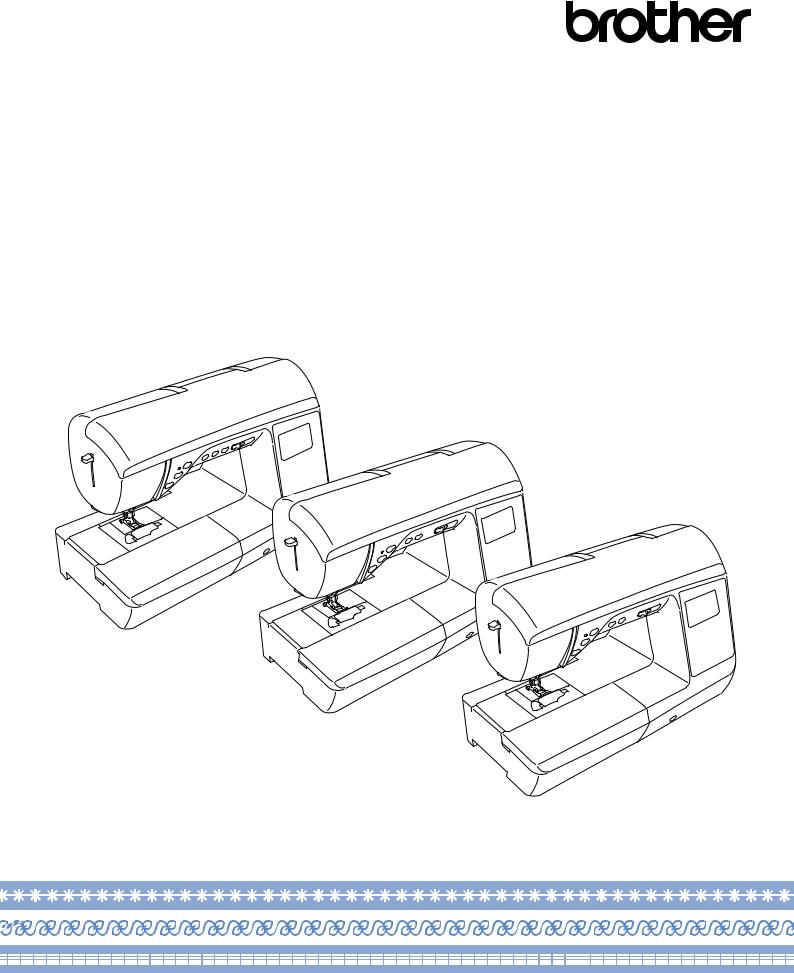
Operation Manual
Sewing Machine
Product Code: 888-F50/F52/F60/F62/F70/F72
Be sure to read this document before using the machine.
We recommend that you keep this document nearby for future reference.
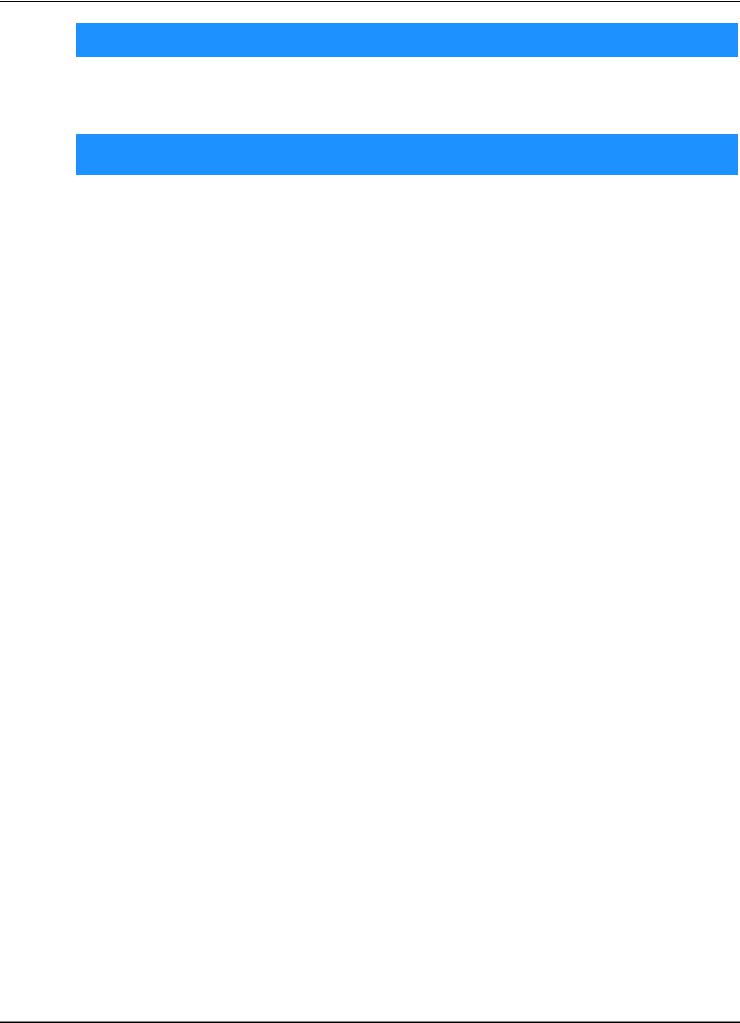
INTRODUCTION
INTRODUCTION
Thank you for purchasing this machine. Before using this machine, carefully read the “IMPORTANT SAFETY INSTRUCTIONS”, and then study this manual for the correct operation of the various functions.
In addition, after you have finished reading this manual, store it where it can quickly be accessed for future reference.
IMPORTANT SAFETY INSTRUCTIONS
Please read these safety instructions before attempting to use the machine.
 DANGER - To reduce the risk of electrical shock
DANGER - To reduce the risk of electrical shock
1Always unplug the machine from the electrical outlet immediately after using, when cleaning, making any user servicing adjustments mentioned in this manual, or if you are leaving the machine unattended.
 WARNING - To reduce the risk of burns, fire, electrical shock, or injury to
WARNING - To reduce the risk of burns, fire, electrical shock, or injury to
persons.
2Always unplug the machine from the electrical outlet when making any adjustments mentioned in the instruction manual.
•To unplug the machine, switch the machine to the symbol “O” position to turn it off, then grasp the plug and pull it out of the electrical outlet. Do not pull on the cord.
•Plug the machine directly into the electrical outlet. Do not use an extension cord.
•Always unplug your machine if there is a power failure.
3Electrical Hazards:
•This machine should be connected to an AC power source within the range indicated on the rating label. Do not connect it to a DC power source or converter. If you are not sure what kind of power source you have, contact a qualified electrician.
•This machine is approved for use in the country of purchase only.
4Never operate this machine if it has a damaged cord or plug, if it is not working properly, has been dropped or
damaged, or water is spilled on the unit. Return the machine to the nearest authorized Brother dealer for examination, repair, electrical or mechanical adjustment.
•While the machine is stored or in use if you notice anything unusual, such as an odor, heat, discoloration or deformation, stop using the machine immediately and unplug the power cord.
•When transporting the machine, be sure to carry it by its handle. Lifting the machine by any other part may damage the machine or result in the machine falling, which could cause injuries.
•When lifting the machine, be careful not to make any sudden or careless movements, which may cause a personal injury.
i
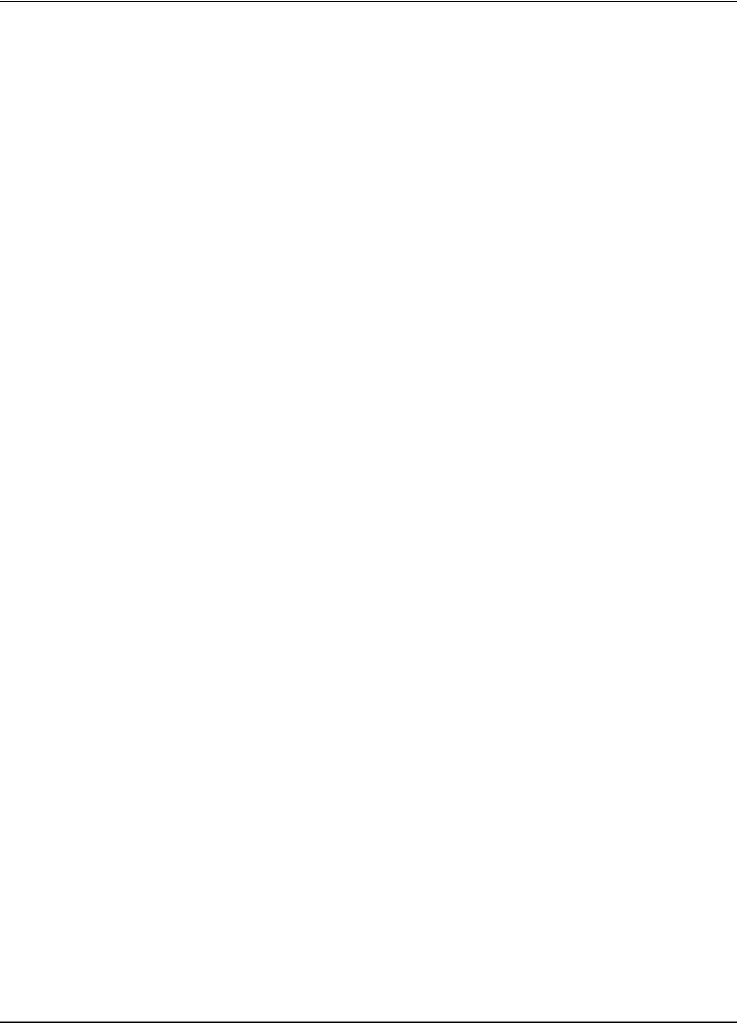
IMPORTANT SAFETY INSTRUCTIONS
5Always keep your work area clear:
•Never operate the machine with any air openings blocked. Keep ventilation openings of the machine and foot control free from the build up of lint, dust, and loose cloth.
•Do not store objects on the foot controller.
•Do not use extension cords. Plug the machine directly into the electrical outlet.
•Never drop or insert foreign objects in any opening.
•Do not operate where aerosol (spray) products are being used or where oxygen is being administered.
•Do not use the machine near a heat source, such as a stove or iron; otherwise, the machine, power cord or garment being sewn may ignite, resulting in fire or an electric shock.
•Do not place this machine on an unstable surface, such as an unsteady or slanted table, otherwise the machine may fall, resulting in injuries.
6Special care is required when sewing:
•Always pay close attention to the needle. Do not use bent or damaged needles.
•Keep fingers away from all moving parts. Special care is required around the machine needle.
•Switch the machine to the symbol “O” position to turn it off when making any adjustments in the needle area.
•Do not use a damaged or incorrect needle plate, as it could cause the needle to break.
•Do not push or pull the fabric when sewing, and follow careful instruction when free motion stitching so that you do not deflect the needle and cause it to break.
7This machine is not a toy:
•Your close attention is necessary when the machine is used by or near children.
•The plastic bag that this machine was supplied in should be kept out of the reach of children or disposed of. Never allow children to play with the bag due to the danger of suffocation.
•Do not use outdoors.
8For a longer service life:
•When storing this machine, avoid direct sunlight and high humidity locations. Do not use or store the machine near a space heater, iron, halogen lamp, or other hot objects.
•Use only neutral soaps or detergents to clean the case. Benzene, thinner, and scouring powders can damage the case and machine, and should never be used.
•Always consult the Operation Manual when replacing or installing any assemblies, the presser feet, needle, or other parts to assure correct installation.
9For repair or adjustment:
•If the light unit is damaged, it must be replaced by an authorized Brother dealer.
•In the event a malfunction occurs or adjustment is required, first follow the troubleshooting table in the back of the Operation Manual to inspect and adjust the machine yourself. If the problem persists, please consult your local authorized Brother dealer.
Use this machine only for its intended use as described in the manual.
Use accessories recommended by the manufacturer as contained in this manual.
The contents of this manual and specifications of this product are subject to change without notice. For additional product information, visit our website at www.brother.com
ii
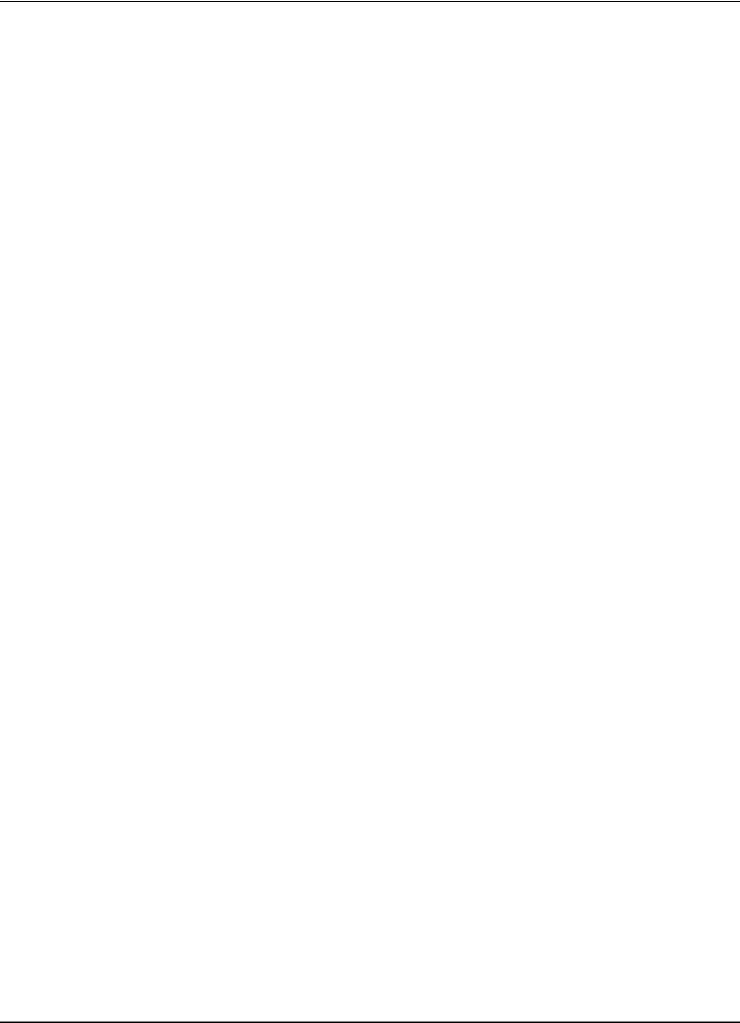
IMPORTANT SAFETY INSTRUCTIONS
SAVE THESE INSTRUCTIONS
This machine is intended for household use.
FOR USERS IN COUNTRIES EXCEPT EUROPEAN COUNTRIES
This appliance is not intended for use by persons (including children) with reduced physical, sensory or mental capabilities, or lack of experience and knowledge, unless they have been given supervision or instruction concerning use of the appliance by a person responsible for their safety. Children should be supervised to ensure that they do not play with the appliance.
FOR USERS IN EUROPEAN COUNTRIES
This appliance can be used by children aged from 8 years and above and persons with reduced physical, sensory or mental capabilities or lack of experience and knowledge if they have been given supervision or instruction concerning use of the appliance in a safe way and understand the hazards involved. Children shall not play with the appliance. Cleaning and user maintenance shall not be made by children without supervision.
FOR USERS IN THE UK, EIRE, MALTA
AND CYPRUS ONLY
IMPORTANT
•In the event of replacing the plug fuse, use a fuse approved by ASTA to BS 1362, i.e. carrying the  mark, rating as marked on plug.
mark, rating as marked on plug.
•Always replace the fuse cover. Never use plugs with the fuse cover omitted.
•If the available electrical outlet is not suitable for the plug supplied with this equipment, you should contact your authorized Brother dealer to obtain the correct lead.
iii

ABOUT THIS MANUAL
ABOUT THIS MANUAL
This manual was written for several machine models.
The machine models are categorized according to their specifications and referred to as “Model” followed by a number. Refer to the Quick Reference Guide for the model of your machine.
The screen displays may differ from the ones displayed on your machine.
Refer to the Quick Reference Guide for details on accessories, settings screen and pre-programmed stitch patterns.
First, read “Functions available with each model” and “Using the utility stitch tables in the “Sewing” section” on page B-8.
WHAT YOU CAN DO WITH THIS MACHINE
B Basic operations
After purchasing your machine, be sure to read this section first. This section provides details on the initial setup procedures as well as descriptions of this machine’s more useful functions.
Chapter 1 GETTING READY |
Page B-2 |
To learn the operation of the principal parts and the screens |
Page B-33 |
Chapter 2 STARTING TO SEW |
|
To learn how to prepare for sewing and basic sewing operations |
|
|
|
S Sewing |
|
This section describes procedures for using the various utility stitches as well as other functions. It provides details on basic machine sewing in addition to the more expressive features of the machine, such as sewing tubular pieces and buttonholes.
Chapter 1 SEWING ATTRACTIVE FINISHES |
Page S-2 |
Tips for sewing attractive finishes and various fabrics |
|
Chapter 2 UTILITY STITCHES |
Page S-6 |
Sew pre-programmed frequently used stitches |
|
D Decorative sewing
This section provides instructions on sewing character stitches and decorative stitches as well as on adjusting and editing them. In addition, it describes how to use MY CUSTOM STITCH, which allows you to create original stitch patterns.
Chapter 1 CHARACTER / DECORATIVE STITCHES |
Page D-2 |
The variety of stitches widen your creativity |
|
Chapter 2 MY CUSTOM STITCH |
Page D-12 |
Create original decorative stitches |
|
A Appendix
This section provides important information for operating this machine. |
Page A-2 |
Chapter 1 MAINTENANCE AND TROUBLESHOOTING |
|
The various maintenance and troubleshooting procedures are described. |
|
iv
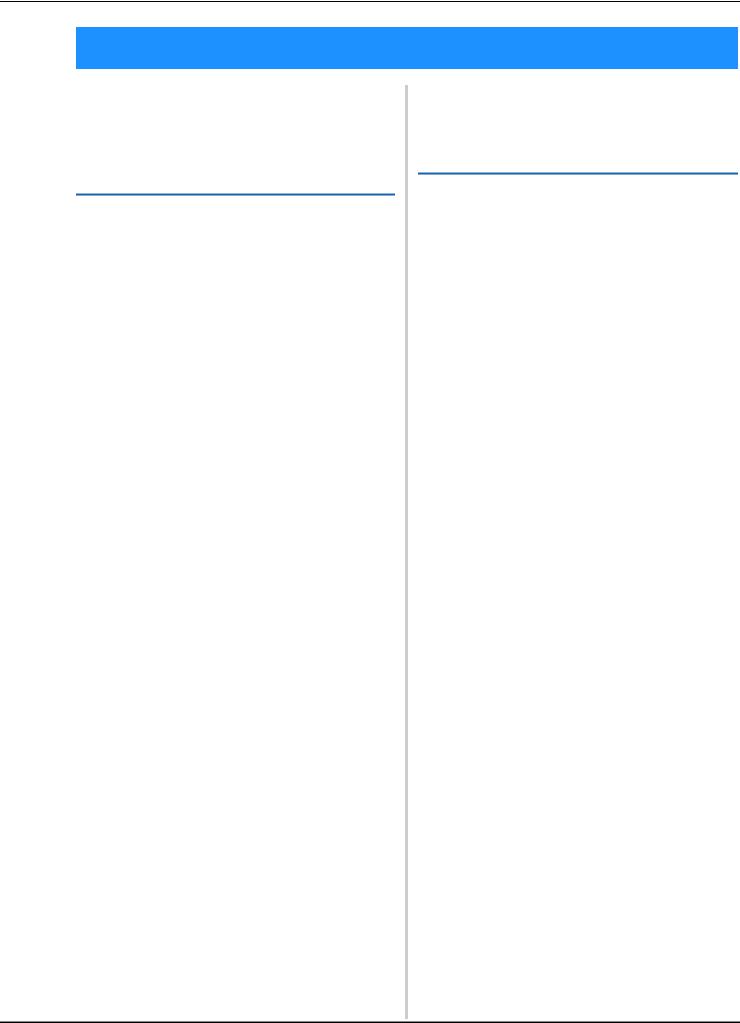
CONTENTS
CONTENTS |
|
INTRODUCTION.................................................. |
i |
IMPORTANT SAFETY INSTRUCTIONS ................. |
i |
ABOUT THIS MANUAL ...................................... |
iv |
WHAT YOU CAN DO WITH THIS MACHINE.... |
iv |
B Basic operations |
|
Chapter 1 GETTING READY |
2 |
Names of Machine Parts and Their Functions ...... |
2 |
Machine ................................................................................ |
2 |
Needle and presser foot section .................................................. |
3 |
Operation buttons .................................................................. |
3 |
Operation panel and operation keys ...................................... |
4 |
Using the flat bed attachment ................................................ |
5 |
Included accessories .............................................................. |
6 |
Optional accessories .............................................................. |
7 |
Functions available with each model ..................................... |
8 |
Using the utility stitch tables in the “Sewing” section ............. |
8 |
Turning the Machine On/Off................................ |
9 |
Turning on the machine ....................................................... |
10 |
Turning off the machine ....................................................... |
10 |
Select machine setting for the first time ................................ |
10 |
LCD .................................................................... |
11 |
Viewing the LCD ................................................................. |
11 |
Settings screen ..................................................................... |
12 |
Choosing the display language............................................. |
14 |
Adjusting input sensitivity for operation keys ....................... |
14 |
Winding/Installing the Bobbin............................ |
15 |
Winding the bobbin ............................................................. |
15 |
Installing the bobbin ............................................................ |
18 |
Upper Threading ................................................ |
21 |
Threading the upper thread .................................................. |
21 |
Threading the needle ........................................................... |
23 |
Threading the needle manually (without using the needle |
|
threader) .............................................................................. |
24 |
Pulling up the bobbin thread................................................ |
24 |
Using the twin needle .......................................................... |
25 |
Replacing the Needle ......................................... |
28 |
Fabric/thread/needle combinations ...................................... |
28 |
Checking the needle ............................................................ |
29 |
Replacing the needle ........................................................... |
29 |
Replacing the Presser Foot ................................. |
31 |
Replacing the presser foot .................................................... |
31 |
Removing and attaching the presser foot holder ................... |
32 |
Chapter 2 STARTING TO SEW |
33 |
Sewing................................................................ |
33 |
Stitch selection methods ...................................................... |
33 |
Selecting a stitch pattern ...................................................... |
34 |
Sewing a stitch ..................................................................... |
35 |
Sewing reinforcement stitches .............................................. |
37 |
Automatic reinforcement stitching ....................................... |
37 |
Setting the Stitch ................................................ |
39 |
Setting the stitch width ......................................................... |
39 |
Setting the stitch length ........................................................ |
39 |
Setting the thread tension ..................................................... |
40 |
Saving stitch settings ............................................................ |
41 |
Useful Functions................................................. |
42 |
Automatically cutting the thread .......................................... |
42 |
Mirroring stitches ................................................................. |
42 |
Adjusting the presser foot pressure ....................................... |
43 |
Automatic Fabric Sensor System (Automatic presser foot |
|
pressure) .............................................................................. |
43 |
Pivoting ............................................................................... |
43 |
Sewing with free motion mode............................................. |
44 |
Hands-free raising and lifting of the presser foot ................... |
45 |
Stitch Setting Chart ............................................ |
46 |
S Sewing |
|
Chapter 1 SEWING ATTRACTIVE |
|
FINISHES |
2 |
Sewing Tips .......................................................... |
2 |
Trial sewing............................................................................ |
2 |
Changing the sewing direction.................................................. |
2 |
Sewing curves ........................................................................ |
2 |
Sewing cylindrical pieces ....................................................... |
2 |
Sewing an even seam allowance ............................................ |
3 |
Sewing Various Fabrics ........................................ |
4 |
Sewing thick fabrics ............................................................... |
4 |
Sewing thin fabrics ................................................................. |
4 |
Sewing stretch fabrics............................................................. |
5 |
Sewing leathers or vinyl fabrics .............................................. |
5 |
Sewing hook-and-loop fastener tape....................................... |
5 |
Chapter 2 UTILITY STITCHES |
6 |
Basic Stitching...................................................... |
6 |
Basting ................................................................................... |
6 |
Basic stitching ........................................................................ |
6 |
Blind Hem Stitching ............................................. |
8 |
Overcasting Stitches .......................................... |
11 |
Sewing overcasting stitches using overcasting foot “G” ........ |
11 |
Sewing overcasting stitches using zigzag foot “J” .................. |
12 |
Sewing overcasting stitches using the side cutter |
|
(sold separately with some models) ...................................... |
12 |
Buttonhole Stitching/Button Sewing .................. |
14 |
Buttonhole sewing................................................................ |
14 |
Button sewing ...................................................................... |
17 |
Zipper Insertion ................................................. |
19 |
Inserting a centered zipper ................................................... |
19 |
Inserting a side zipper .......................................................... |
20 |
Zipper/piping Insertion ...................................... |
23 |
Inserting a centered zipper ................................................... |
23 |
Inserting a piping.................................................................. |
24 |
Sewing Stretch Fabrics and Elastic Tape............. |
25 |
Stretch stitching.................................................................... |
25 |
Elastic attaching ................................................................... |
25 |
Appliqué, Patchwork and Quilt Stitching........... |
26 |
Appliqué stitching ................................................................ |
26 |
Patchwork (crazy quilt) stitching........................................... |
27 |
Piecing ................................................................................. |
27 |
Quilting................................................................................ |
29 |
Free motion quilting ............................................................. |
30 |
Satin stitching using the sewing speed controller .................. |
34 |
Reinforcement Stitching..................................... |
35 |
Triple stretch stitching .......................................................... |
35 |
Bar tack stitching.................................................................. |
35 |
Darning................................................................................ |
36 |
Eyelet Stitching .................................................. |
38 |
Attaching Patches or Emblems to Shirt Sleeves .... |
39 |
Decorative Stitching .......................................... |
41 |
Fagoting ............................................................................... |
41 |
Scallop stitching ................................................................... |
42 |
Smocking ............................................................................. |
42 |
Shell tuck stitching ............................................................... |
43 |
Joining.................................................................................. |
43 |
Heirloom stitching................................................................ |
44 |
v
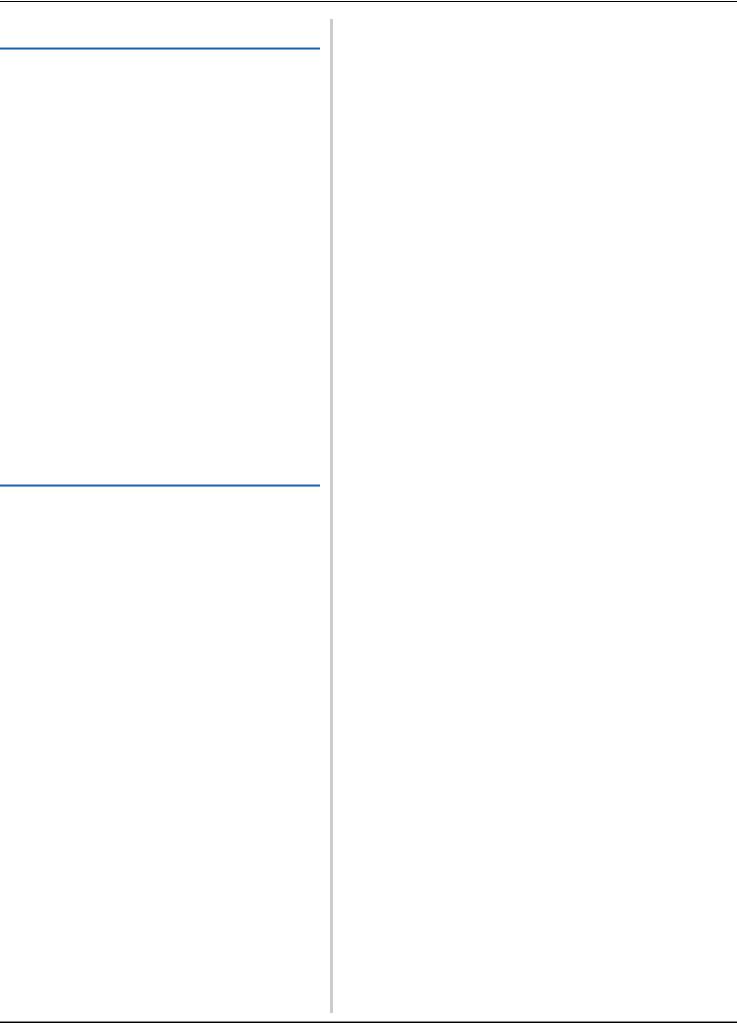
CONTENTS
D Decorative sewing |
|
Chapter 1 CHARACTER / DECORATIVE |
|
STITCHES |
2 |
Sewing the Various Built-in Decorative Patterns .... |
2 |
Selecting stitch patterns .......................................................... |
2 |
Deleting a pattern................................................................... |
3 |
Sewing attractive finishes ....................................................... |
3 |
Basic sewing .......................................................................... |
4 |
Combining patterns ................................................................ |
5 |
Repeating combined patterns ................................................. |
5 |
Checking the selected pattern................................................. |
6 |
Changing the pattern size ....................................................... |
6 |
Changing the stitch density..................................................... |
6 |
Changing the pattern length ................................................... |
7 |
Changing character spacing ................................................... |
7 |
Creating step stitch patterns.................................................... |
7 |
Mirroring a pattern image....................................................... |
8 |
Returning to the beginning of the pattern................................ |
9 |
Saving a pattern...................................................................... |
9 |
Retrieving a pattern .............................................................. |
10 |
Realigning the pattern .......................................................... |
10 |
Chapter 2 MY CUSTOM STITCH |
12 |
Designing a Stitch............................................... |
12 |
Drawing a sketch of the pattern............................................ |
12 |
Entering the pattern data....................................................... |
12 |
Examples of designs ............................................................. |
14 |
A Appendix |
|
Chapter 1 MAINTENANCE AND |
|
TROUBLESHOOTING |
2 |
Care and Maintenance.......................................... |
2 |
Restrictions on oiling.............................................................. |
2 |
Precautions on storing the machine........................................ |
2 |
Cleaning the LCD screen........................................................ |
2 |
Cleaning the machine surface ................................................ |
2 |
Cleaning the race ................................................................... |
2 |
Troubleshooting.................................................... |
4 |
Frequent troubleshooting topics ............................................. |
4 |
Upper thread tightened up ..................................................... |
4 |
Tangled thread on wrong side of fabric .................................. |
5 |
Incorrect thread tension.......................................................... |
6 |
Fabric is caught in the machine and cannot be removed ........ |
8 |
When the thread became tangled under the bobbin winder |
|
seat ...................................................................................... |
10 |
List of symptoms................................................................... |
12 |
Error messages...................................................................... |
17 |
Operation beep .................................................................... |
20 |
Nothing appears in the LCD ................................................. |
20 |
Specifications ..................................................... |
20 |
Index .................................................................. |
21 |
vi

 Basic
Basic
operations
This section provides details on the initial setup procedures as well as descriptions of this machine’s more useful functions.
Page number starts with “B” in this section. |
|
Chapter1 GETTING READY.................................................... |
B-2 |
|
|
Chapter2 STARTING TO SEW .............................................. |
B-33 |
|
|
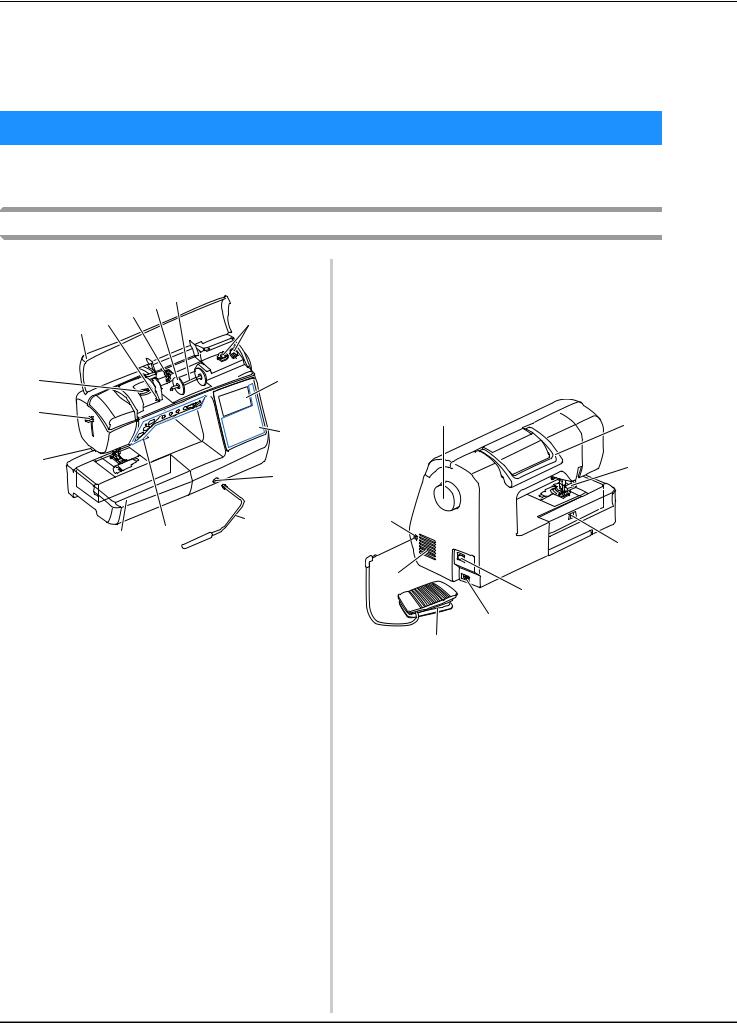
Names of Machine Parts and Their Functions
Chapter 1 GETTING READY
Names of Machine Parts and Their Functions
The names of the various parts of the machine and their functions are described below. Before using the machine, carefully read these descriptions to learn the names of the machine parts and their locations.
Machine
■ Front view
|
c |
d e |
|
a b |
f |
||
|
|||
o |
|
g |
|
n |
|
|
|
|
|
h |
|
m |
|
|
|
|
|
i |
|
|
|
j |
|
|
l |
k |
|
|
|
1Top cover
Open the top cover to place the spool of thread on the spool pin.
2Thread guide plate
Pass the thread around the thread guide plate when threading the upper thread.
3Bobbin winding thread guide and pretension disk
Pass the thread under this thread guide and around the pretension disk when winding the bobbin thread.
4Spool cap
Use the spool cap to hold the spool of thread in place.
5Spool pin
Place a spool of thread on the spool pin.
6Bobbin winder
Use the bobbin winder when winding the bobbin.
7LCD (liquid crystal display)
Settings for the selected stitch and error messages appear in the LCD. (page B-11)
8Operation panel
From the operation panel, stitch settings can be selected and edited, and operations for using the machine can be selected (page B-4).
9Knee lifter mounting slot
Insert the knee lifter into the knee lifter mounting slot.
0Knee lifter
Use the knee lifter to raise and lower the presser foot. (page B-45)
AOperation buttons and sewing speed controller
Use these buttons and the slide to operate the machine. (page B-3)
BFlat bed attachment
Insert the presser foot accessory tray into the accessory compartment of the flat bed attachment. Remove the flat bed attachment when sewing cylindrical pieces such as sleeve cuffs.
CThread cutter
Pass the threads through the thread cutter to cut them.
DNeedle threader lever
Use the needle threader lever to thread the needle.
EThread tension dial
(Equipped on some models. Refer to page B-8)
Use the dial to adjust the upper thread tension. (page B-40)
■ Right-side/rear view
a |
b |
|
c
i
d
h
e
f
g
1Handwheel
Turn the handwheel toward you (counterclockwise) to raise and lower the needle to sew one stitch.
2Handle
Carry the machine by its handle when transporting.
3Presser foot lever
Raise and lower the presser foot lever to raise and lower the presser foot.
4Feed dog position switch
Use the feed dog position switch to lower the feed dogs.
5Main power switch
Use the main power switch to turn the machine on and off.
6Power supply jack
Insert the plug on the power supply cord into the power supply jack.
7Foot controller
Depress the foot controller to control the speed of the machine. (page B-36)
8Air vent
The air vent allows the air surrounding the motor to circulate. Do not cover the air vent while the machine is being used.
9Foot controller jack
Insert the plug on the end of the foot controller cable into the foot controller jack.
B-2
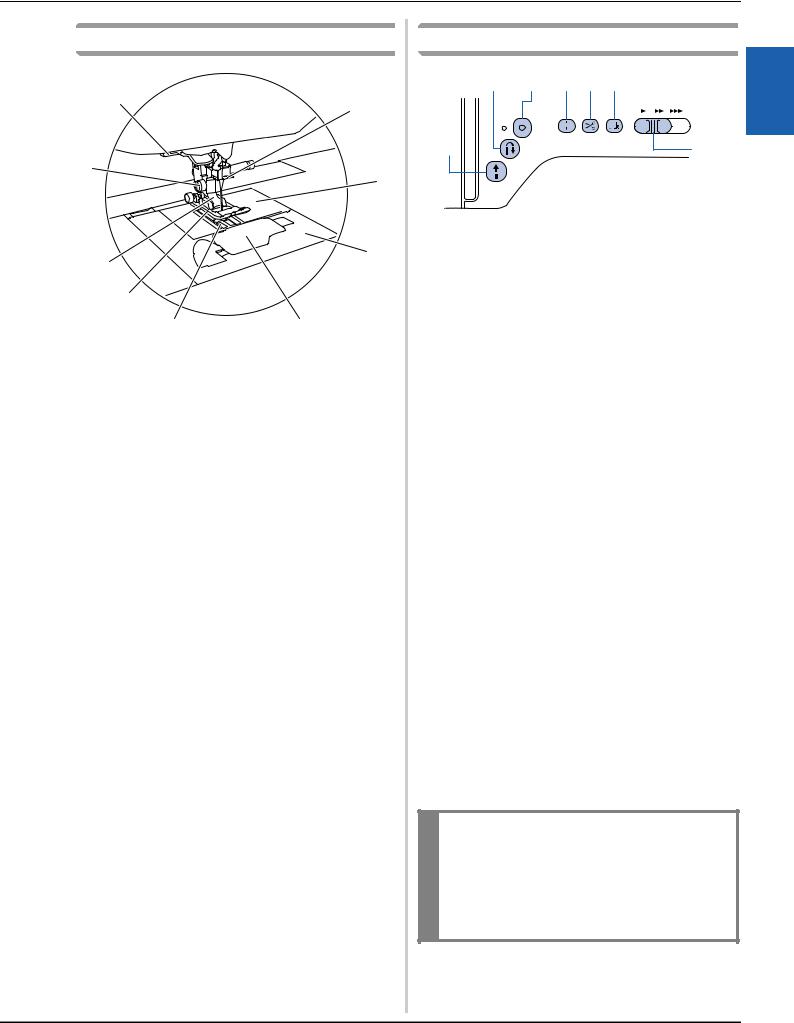
Needle and presser foot section
i
a
h
b
c
g
f
e |
d |
1Needle bar thread guide
Pass the upper thread through the needle bar thread guide.
2Needle plate
The needle plate is marked with guides for sewing straight seams.
3Needle plate cover
Remove the needle plate cover to clean the bobbin case and race.
4Bobbin cover/bobbin case
Remove the bobbin cover, and then insert the bobbin into the bobbin case.
5Feed dogs
The feed dogs feed the fabric in the sewing direction.
6Presser foot
The presser foot applies pressure consistently on the fabric as the sewing takes place. Attach the appropriate presser foot for the selected stitch.
7Presser foot holder
The presser foot is attached onto the presser foot holder.
8Presser foot holder screw
Use the presser foot holder screw to hold the presser foot in place. (page B-32)
9Buttonhole lever
Lower the buttonhole lever when sewing buttonholes and bar tacks or when darning.
Names of Machine Parts and Their Functions
Operation buttons
b c d e f
a |
g |
1“Start/Stop” button 
Press the “Start/Stop” button to start or stop sewing. The machine stitches at a slow speed at the beginning of sewing while the button is pressed. When sewing is stopped, the needle is lowered in the fabric. For details, refer to “STARTING TO SEW” on page B-33.
The button changes color according to the machine’s operation mode.
Green: |
The machine is ready to sew or is sewing. |
Red: |
The machine can not sew. |
Orange: |
The machine is winding the bobbin thread, or |
|
the bobbin winder shaft is moved to the right |
|
side. |
2Reverse stitch button 
For straight, zigzag, and elastic zigzag stitch patterns that use reverse stitches, the machine will sew reverse stitches at low speed only while holding down the Reverse stitch button. The stitches are sewn in the opposite position.
For other stitches, use this button to sew reinforcement stitches at the beginning and end of sewing. Press and hold this button, and the machine sews 3 stitches in the same spot and stops automatically. (page B-37)
3Reinforcement stitch button 
Use this button to sew a single stitch repeatedly and tie-off. For character/decorative stitches, press this button to end with a full stitch instead of at a mid-point. The LED light beside this button lights up while the machine is sewing a full motif, and automatically turns off when the sewing is stopped. (page B- 37)
4Needle position button 
Press the needle position button to raise or lower the needle. Pressing the button twice sews one stitch.
5Thread cutter button 
Press the thread cutter button after sewing is stopped to cut
both the upper and the bobbin threads. For details, refer to step junder “Sewing a stitch” section on page B-35.
6Presser foot lifter button 
(Equipped on some models. Refer to page B-8)
Press this button to lower the presser foot and apply pressure to the fabric. Press this button again to raise the presser foot.
7Sewing speed controller
Slide the sewing speed controller to adjust the sewing speed.
 CAUTION
CAUTION
•Do not press  (Thread cutter button) after the threads have already been cut, otherwise the needle may break, the threads may become tangled or damage to the machine may occur.
(Thread cutter button) after the threads have already been cut, otherwise the needle may break, the threads may become tangled or damage to the machine may occur.
B
READY GETTING
Basic operations B-3
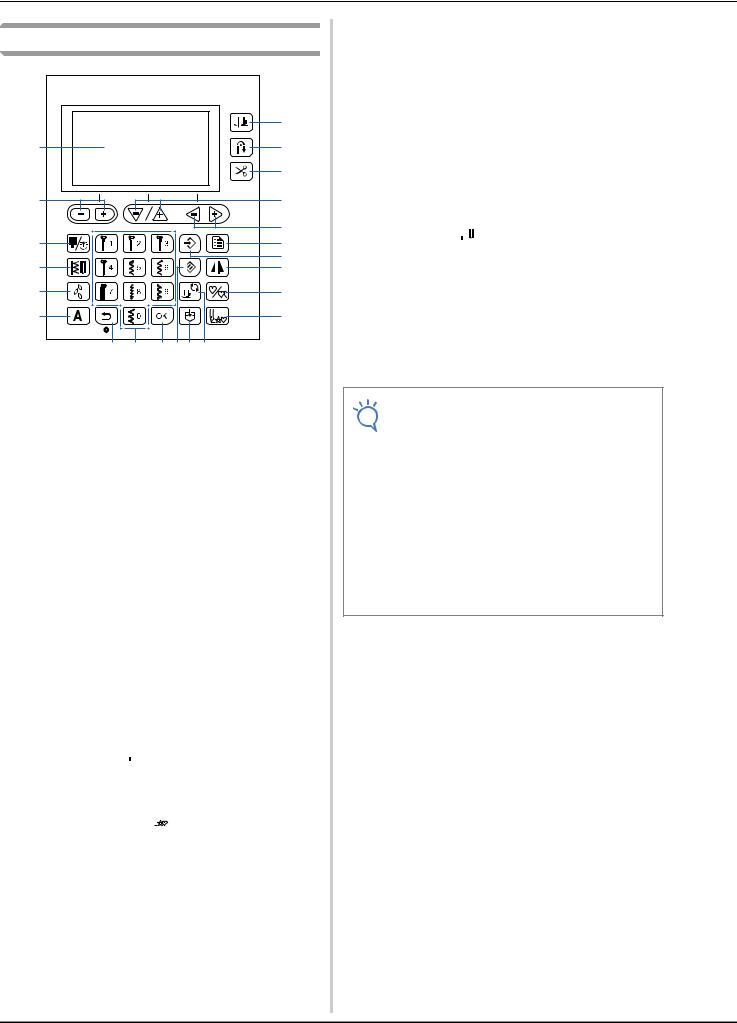
Names of Machine Parts and Their Functions
Operation panel and operation keys
|
b |
a |
c |
|
d |
v |
e |
|
f |
u |
g |
|
h |
t |
i |
s |
j |
r |
k |
q p |
onml |
The keys with * are lit while they are ON.
1LCD (liquid crystal display)
Settings for the selected stitch and error messages for incorrect operations appear in the LCD.
For details, refer to “LCD” on page B-11
2 Pivot key  *
*
(Equipped on some models. Refer to page B-8)
Press to activate pivot function.
3Automatic reverse/reinforcement key  *
*
Press to use the automatic reverse/reinforcement stitching function.
4Automatic thread cutting key  *
*
Press to select the automatic thread cutting function.
5Stitch length keys/Item selection keys 


Press to adjust the stitch length or to select the next/previous items in the settings screen.
6Thread tension keys (Equipped on some models.
Refer to page B-8)/Value selection keys 

Press to adjust the thread tension or to change the value of the selected item in the settings screen.
7Settings key 
Press to select sewing settings or other settings, or to move to next pages in the settings screen.
8Manual memory key 
Press to save the adjusted stitch width and length settings. For models equipped with the thread tension keys (Refer to
page B-8.), the thread tension setting is also saved.
9Mirror image key 
Press to create a mirror image of the selected stitch pattern.
0Single/repeat sewing key 
Press to choose single pattern or continuous patterns.
ABack to beginning key 
Press this key to return to the beginning of the pattern.
BPresser foot/Needle exchange key 
Press this key before changing the needle, the presser foot, etc.
This key locks all key and button functions to prevent operation of the machine.
CMemory key 
Press to save stitch pattern combinations to machine memory.
DReset key 
Press to reset the selected stitch to its original settings.
E OK key 
Press to apply the selection or perform the operation.
FNumeric keys
Use these keys to quickly select one of the ten most often used stitches. When selecting other stitches, use these keys to type in the number of the desired stitch.
GBack key 
Press this key to cancel the operation and return to the previous screen.
In addition, pressing this key removes the last pattern added when combining characters or decorative stitches.
HCharacter stitch key  *
*
Press to select a character stitch.
IDecorative stitch key  *
*
Press to select a decorative stitch.
JUtility stitch key  *
*
Press to select a utility stitch.
KPreset utility stitch/saved pattern key  *
*
Press to select the utility stitch assigned to a numeric key or to retrieve a pattern that has been saved.
LStitch width keys/Settings screen page selection
keys 
Press to adjust the stitch width or to move to previous/next pages in the settings screen.
Note
•The operation keys of this machine are capacitive touch sensors. Operate the keys by directly touching them with your finger.
The response of the keys varies according to the user.
The pressure exerted on the keys does not affect the response of the keys.
•Since the operation keys react differently depending on the user, adjust the setting for the input sensitivity. (page B-14)
•When using an electrostatic touch pen, make sure that its point is 8 mm or more. Do not use a touch pen with a thin point or a unique shape.
B-4
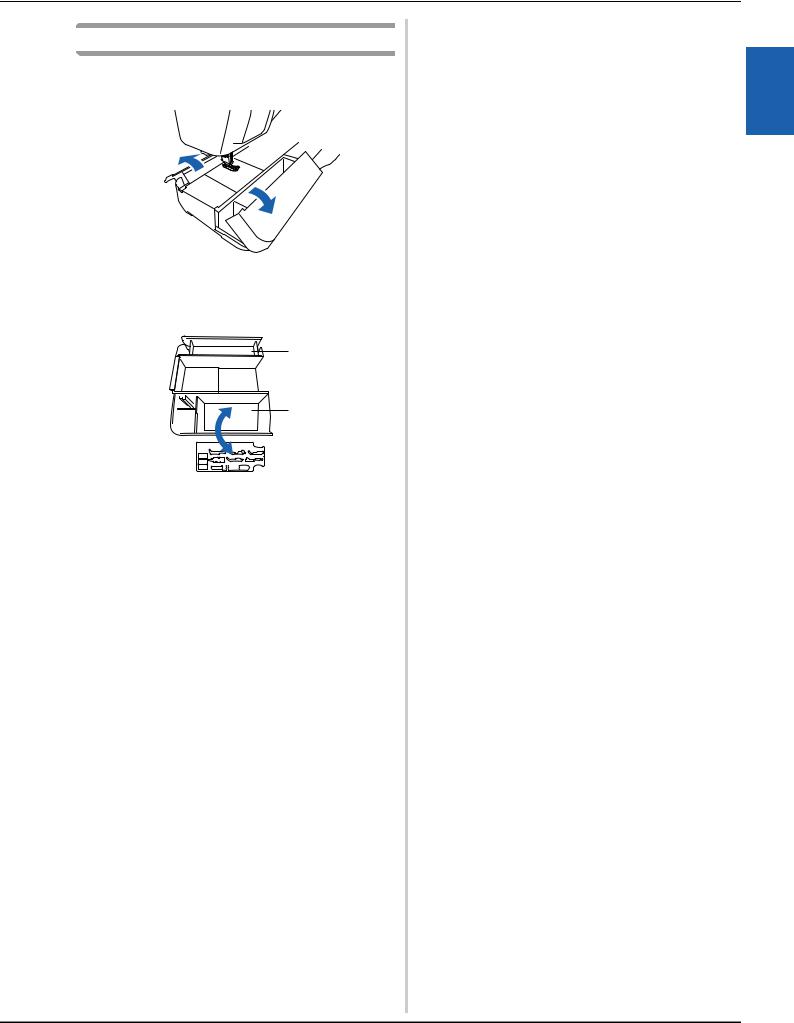
Names of Machine Parts and Their Functions
Using the flat bed attachment
Pull the top of the flat bed attachment to open the accessory compartments.
A presser foot accessory tray is stored in the accessory compartment of the flat bed attachment.
1
1

 2
2
1 Storage space of the flat bed attachment
2 Presser foot accessory tray
B
READY GETTING
Basic operations B-5
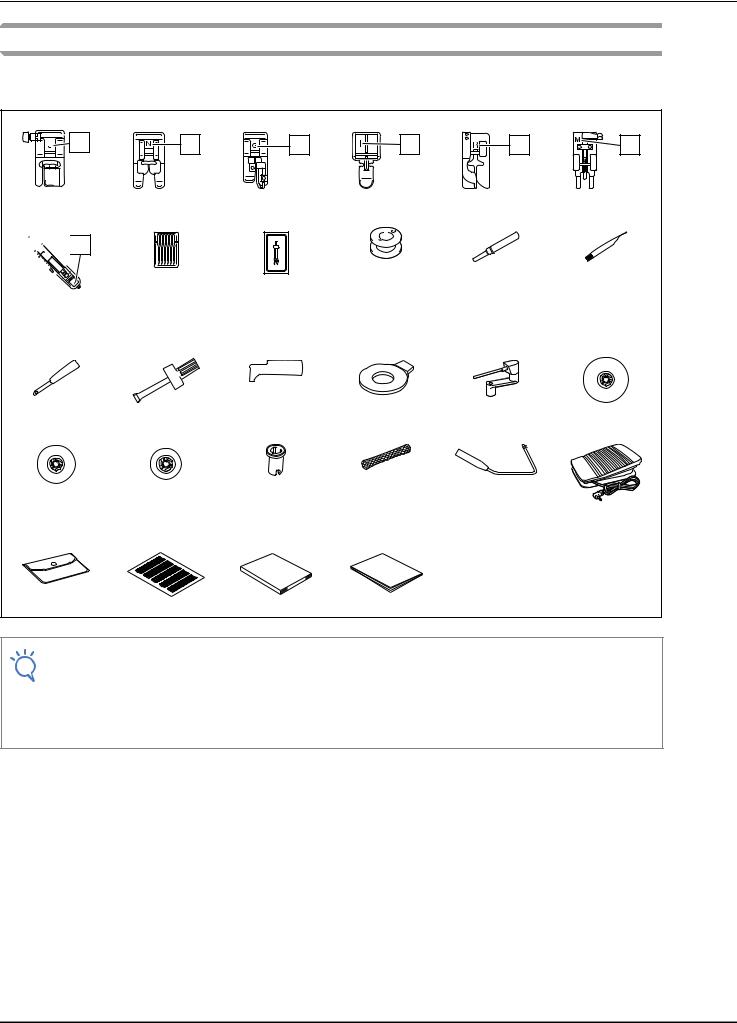
Names of Machine Parts and Their Functions
Included accessories
Included accessories may differ from the table below depending on your model. For more details on included accessories and their part codes of your machine, refer to the Quick Reference Guide.
1. |
2. |
3. |
4. |
5. |
6. |
J |
N |
G |
I |
R |
M |
Zigzag foot “J” (on machine) |
Monogramming foot “N” |
Overcasting foot “G” |
Zipper foot “I” |
Blind stitch foot “R” |
Button fitting foot “M” |
7. |
8. |
9. |
10. |
11. |
12. |

 A
A
Buttonhole foot “A” |
Needle set |
Twin needle |
Bobbin (4) |
Seam ripper |
Cleaning brush |
|
75/11 2 needles, 90/14 2 |
2.0/11 needle |
One is on machine. |
|
|
|
needles, 90/14 2 needles: Ball |
|
|
|
|
|
point needle (gold colored) |
|
|
|
|
13. |
14. |
15. |
16. |
17. |
18. |
Eyelet punch |
Screwdriver (large) |
L-shaped screwdriver |
Disc-shaped screwdriver |
Horizontal spool pin |
Spool cap (large) |
19. |
20. |
21. |
22. |
23. |
24. |
Spool cap (medium) (2) |
Spool cap (small) |
Thread spool insert (mini king |
Spool net |
Knee lifter |
Foot controller |
One is on machine. |
|
thread spool) |
|
|
|
25. |
26. |
27. |
28. |
|
|
Accessory bag |
Grid sheet set |
Operation Manual |
Quick Reference Guide |
Note
•(For U.S.A. only) Foot controller: Model T
This foot controller can be used on the machine with product code 888-F50/F60/F70. The product code is mentioned on the machine rating plate.
•The presser foot holder screw is available through your authorized Brother dealer. (Part code: XG1343-001)
•The presser foot accessory tray is available, through your authorized Brother dealer. (Part code: XF8650-001)
B-6
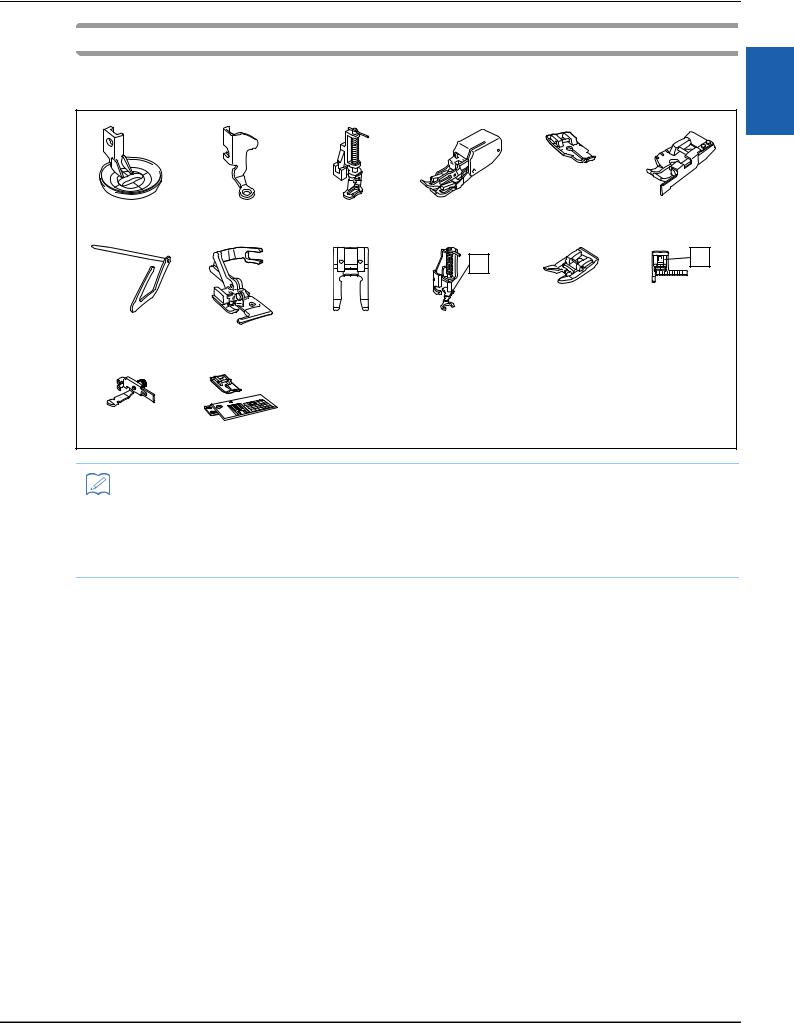
Names of Machine Parts and Their Functions
Optional accessories
The following are available as optional accessories to be purchased separately. Optional accessories differ depending on your model. For more optional accessories and their part codes, refer to the Quick Reference Guide.
1. |
2. |
3. |
4. |
5. |
6. |
Free motion echo quilting foot |
Free motion quilting foot “C” |
Quilting foot |
Walking foot |
1/4" quilting foot |
1/4" quilting foot with guide |
“E” |
|
|
|
|
|
7. |
8. |
9. |
10. |
11. |
12. |
|
|
|
|
O |
P |
|
|
|
|
|
Quilting guide |
Side cutter “S” |
Open toe foot |
Free motion open toe |
Non stick foot |
Stitch guide foot “P” |
|
|
|
quilting foot “O” |
|
|
13. |
14. |
|
|
|
|
Adjustable zipper/piping foot |
Straight stitch foot and needle |
|
|
|
|
|
plate set |
|
|
|
|
Memo
•To obtain optional accessories or parts, contact your authorized Brother dealer.
•All specifications are correct at the time of printing. Please be aware that some specifications may change without notice.
•Visit your nearest authorized Brother dealer for a complete listing of optional accessories available for your machine.
•Always use accessories recommended for this machine.
B
READY GETTING
Basic operations B-7
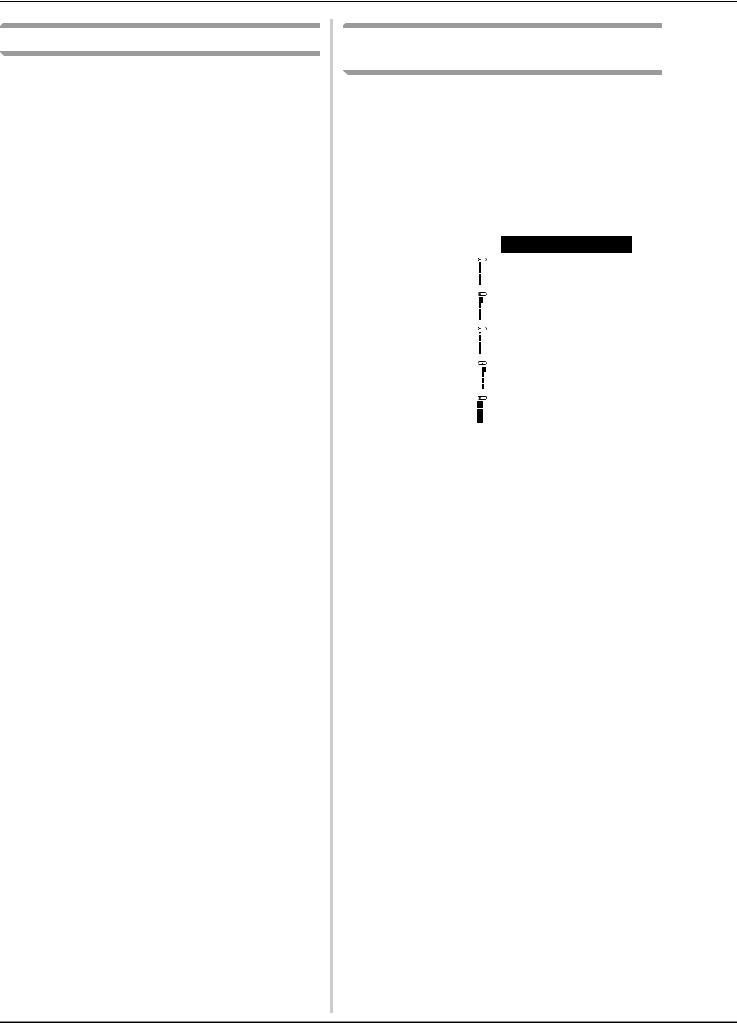
Names of Machine Parts and Their Functions
Functions available with each model
Specifications differ depending on the machine model. For the functions available with your sewing machine model, refer to the table below. Refer to the Quick Reference Guide for the model of your sewing machine.
|
Model 3 |
Model 2 |
Model 1 |
Page |
||||
Automatic fabric |
9 |
|
|
|
|
|
||
sensor system |
N/A |
N/A |
B-43 |
|||||
(setting) |
|
|
|
|
|
|
|
|
|
|
|
|
|
|
|
|
|
Fine adjustment |
9 |
9 |
N/A |
D-10 |
||||
horizontal (setting) |
||||||||
|
|
|
|
|
|
|
|
|
Free motion foot |
9 |
N/A |
N/A |
B-44 |
||||
height (setting) |
||||||||
|
|
|
|
|
|
|
|
|
Free motion mode |
9 |
N/A |
N/A |
B-44 |
||||
(setting) |
||||||||
|
|
|
|
|
||||
Pivoting |
9 |
N/A |
N/A |
B-43 |
||||
Presser foot height |
9 |
N/A |
N/A |
B-13 |
||||
(setting) |
||||||||
|
|
|
|
|
|
|
|
|
Presser foot lifter |
9 |
N/A |
N/A |
B-3 |
||||
button |
||||||||
|
|
|
|
|
|
|
|
|
Size selection |
9 |
*1 |
9 |
*1 |
9 |
*2 |
D-6 |
|
(setting) |
||||||||
|
|
|
|
|||||
Step stitch pattern |
9 |
9 |
N/A |
D-7 |
||||
Thread tension dial |
N/A |
N/A |
9 |
B-40 |
||||
Thread tension key |
9 |
9 |
N/A |
B-40 |
||||
|
|
|
|
|
|
|
|
|
*1 Pattern size can be changed for decorative stitches, satin stitches and all fonts of character stitches.
*2 Pattern size can be changed for character stitches other than handwriting font.
Using the utility stitch tables in the “Sewing” section
The utility stitch numbers differ depending on the model of your machine. Refer to the Quick Reference Guide for the model of your sewing machine.
|
|
Model4 |
|
|
|
|
Presserfoot |
Stitch name |
Stitch |
Model3, 2 |
|
Model1 |
|||
|
|
|
|
|
|
||
|
|
|
|
|
|
|
|
|
|
Stitch number |
|
||||
Basting stitch |
|
1-08 |
08 |
|
07 |
|
|
|
|
|
|
|
|
|
|
|
|
1-01 |
01* |
01* |
|
||
Straight stitch (Left) |
|
|
|
|
|
|
|
|
1-02 |
02* |
02* |
J |
|||
|
|
||||||
|
|
|
|
|
|
|
|
Straight stitch (Middle) |
|
1-03 |
03* |
03* |
|
||
|
|
|
|
|
|
|
|
Triple stretch stitch |
|
1-05 |
05* |
05* |
|
||
|
|
|
|
|
|
|
|
B-8

Turning the Machine On/Off
Turning the Machine On/Off
 WARNING
WARNING
•Use only regular household electricity for the power source. Using other power sources may result in fire, electric shock, or damage to the machine.
•Make sure that the plugs on the power cord are firmly inserted into the electrical outlet and the power cord receptacle on the machine. Otherwise, a fire or electric shock may result.
•Do not insert the plug on the power cord into an electrical outlet that is in poor condition.
•Turn the main power to OFF and remove the plug in the following circumstances: When you are away from the machine
After using the machine
When the power fails during use
When the machine does not operate correctly due to a bad connection or a disconnection During electrical storms
 CAUTION
CAUTION
•Use only the power cord included with this machine.
•Do not use extension cords or multi-plug adapters with any other appliances plugged into them. Fire or electric shock may result.
•Do not touch the plug with wet hands. Electric shock may result.
•When unplugging the machine, always turn the main power to OFF first. Always grasp the plug to remove it from the electrical outlet. Pulling on the cord may damage the cord, or lead to fire or electric shock.
•Do not allow the power cord to be cut, damaged, modified, forcefully bent, pulled, twisted, or bundled. Do not place heavy objects on the cord. Do not subject the cord to heat. These things may damage the cord, or cause fire or electric shock. If the cord or plug is damaged, take the machine to your authorized Brother dealer for repairs before continuing use.
•Unplug the power cord if the machine is not to be used for a long period of time. Otherwise, a fire may result.
•When leaving the machine unattended, either the main switch of the machine should be turned to OFF or the plug must be removed from the electrical outlet.
•When servicing the machine or when removing covers, the machine must be unplugged.
•For USA only
This appliance has a polarized plug (one blade wider than the other). To reduce the risk of electrical shock, this plug is intended to fit in a polarized electrical outlet only one way.
If the plug does not fit fully in the electrical outlet, reverse the plug. If it still does not fit, contact a qualified electrician to install the proper electrical outlet. Do not modify the plug in any way.
B
READY GETTING
Basic operations B-9
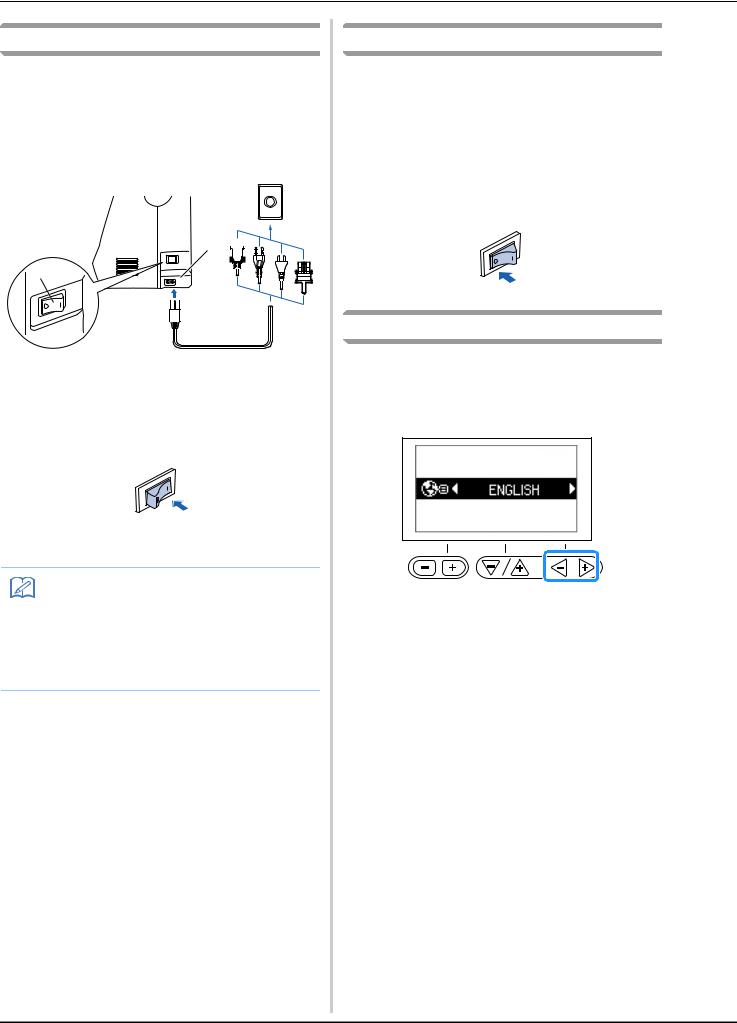
Turning the Machine On/Off
Turning on the machine
aMake sure that the machine is turned off (the main power switch is set to “  ”), and then plug the power cord into the power supply jack on the right side of the machine.
”), and then plug the power cord into the power supply jack on the right side of the machine.
bInsert the plug of the power cord into a household electrical outlet.
1 
2
1 Power supply jack
2 Main power switch
cPress the right side of the main power switch on the right side of the machine to turn the machine on (set it to “I”).
→The light, LCD and the “Start/Stop” button light up when the machine is turned on.
Memo
•When the machine is turned on, the needle and the feed dogs will make a sound when they move; this is not a malfunction.
•If the machine is turned off in the middle of sewing in the “Sewing” function, the operation will not resume after turning the power on again.
Turning off the machine
When you are finished using the machine, turn it off. In addition, before transporting the machine to another location, be sure to turn it off.
aMake sure that the machine is not sewing.
bPress the main power switch on the right side of the machine in the direction of the “  ” symbol to turn the machine off.
” symbol to turn the machine off.
Select machine setting for the first time
When you first turn on the machine, select the language of your choice. Follow the procedure below when the settings screen appears automatically.
aUse the “-” or “+” key to choose the desired language.
bPress  .
.
B-10
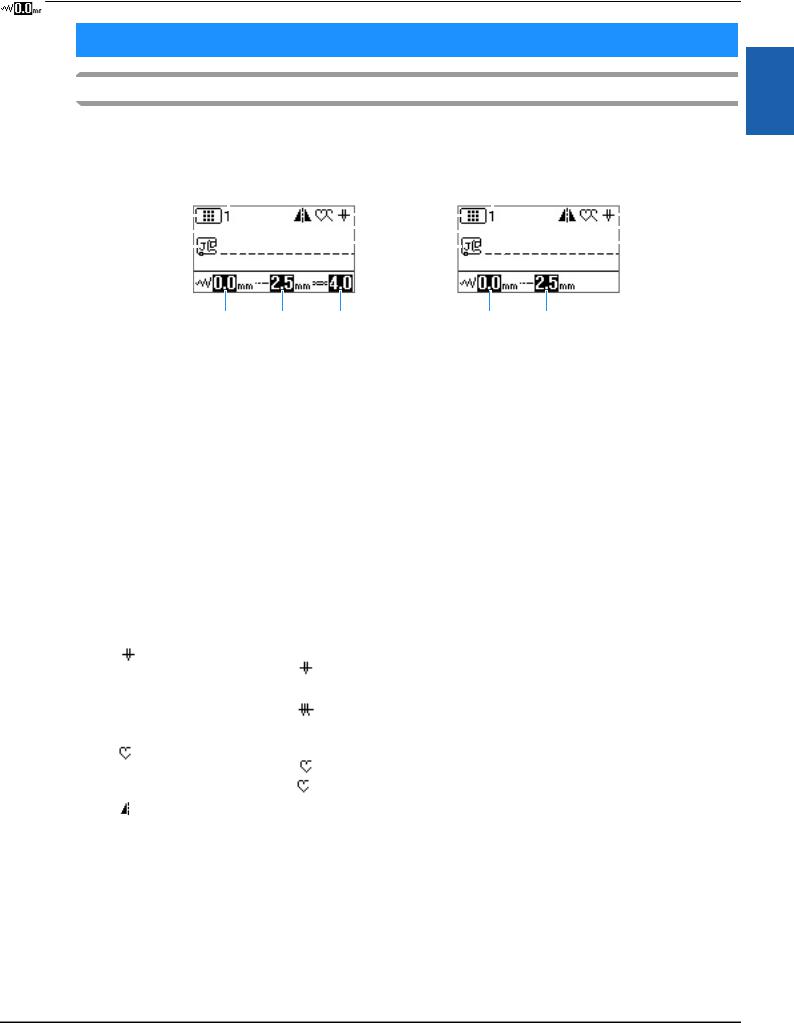
LCD
LCD
Viewing the LCD
When the power is turned on, the LCD comes on, and the following screen is displayed. The screen will vary slightly depending on your machine model.
The screen is changed using the keys below the LCD.
4 |
|
|
|
|
|
|
|
|
|
4 |
|
|
|
|
|
|
|
|
|
|
|
|
|
|
|
|
|
|
|
|
|
|
|
|
|||||||
3 |
|
|
|
|
|
|
|
|
5 |
3 |
|
|
|
|
|
|
|
|
|
5 |
|
|
|
|
|
|
|
|
|
||||||||||||
|
|
|
|
|
|
|
|
|
|
|||||||||||
2 |
|
|
|
|
|
|
|
|
6 |
2 |
|
|
|
|
|
|
|
|
|
6 |
|
|
|
|
|
|
|
|
7 |
|
|
|
|
|
|
|
|
|
7 |
||
1 |
|
|
|
|
|
|
|
|
1 |
|
|
|
|
|
|
|
|
|
||
|
|
|
|
|
|
|
|
|
|
|
|
|
|
|
|
|
||||
|
|
|
|
|
|
|
|
|
|
|
|
|
|
|
|
|
|
|
||
|
|
|
|
|
|
|
|
|
|
|
|
|
|
|
|
|
|
|
|
|
|
|
8 |
9 |
0 |
8 |
9 |
|
|
|
|
|
|
|
|
|
No. |
Display |
Item Name |
|
Explanation |
|
Page |
|
|
|
|
|
|
|
|
|
1 |
|
Presser foot |
|
Shows presser foot to be used. |
|
|
B-31 |
|
|
|
|
|
|
|
|
2 |
- |
Stitch preview |
|
Shows a preview of the selected stitch. |
|
|
B-34 |
|
|
|
|
|
|
||
3 |
|
Stitch category |
|
Shows the category of the currently selected stitch pattern. |
B-33 |
||
|
|
|
|
: Preset utility stitch |
|
|
|
|
|
|
|
: Utility stitch |
|
|
|
|
|
|
|
: Decorative stitch (category 1) |
|
|
|
|
|
|
|
: Decorative stitch (category 2) |
|
|
|
|
|
|
|
: Decorative stitch (category 3) |
|
|
|
|
|
|
|
: Character stitch (Gothic font) |
|
|
|
|
|
|
|
: Character stitch (Handwriting font) |
|
|
|
|
|
|
|
: Character stitch (Outline) |
|
|
|
|
|
|
|
: Character stitch (Cyrillic font) |
|
|
|
|
|
|
|
: Character stitch (Japanese font) |
|
|
|
|
|
|
|
|
|
||
4 |
- |
Stitch number |
|
Shows the number of the currently selected stitch pattern. |
B-46 |
||
|
|
|
|
|
|
||
5 |
|
Needle position setting |
|
Shows single or twin needle mode setting, and the needle stop position. |
B-12 |
||
|
|
|
|
: Single needle/down position |
|
|
|
|
|
|
|
: Single needle/up position |
|
|
|
|
|
|
|
: Twin needle/down position |
|
|
|
|
|
|
|
: Twin needle/up position |
|
|
|
|
|
|
|
|
|
||
6 |
|
Single/repeat sewing |
|
Shows single or continuous patterns sewing mode setting. |
D-5 |
||
|
|
|
|
: Single sewing mode |
|
|
|
|
|
|
|
: Repeat sewing mode |
|
|
|
|
|
|
|
|
|
|
|
7 |
|
Horizontal mirror image |
|
Appears when the stitch is mirrored. |
|
|
B-42 |
|
|
|
|
|
|
||
8 |
|
Stitch width |
|
Shows the stitch width of the currently selected stitch pattern. |
B-39 |
||
|
|
|
|
|
|
||
9 |
|
Stitch length |
|
Shows the stitch length of the currently selected stitch pattern. |
B-39 |
||
|
|
|
|
|
|
||
0 |
|
Thread tension |
|
Shows the automatic thread tension setting for the currently selected stitch pattern. |
B-40 |
||
|
|
(Equipped on some |
|
|
|
|
|
|
|
models. Refer to page |
|
|
|
|
|
|
|
page B-8) |
|
|
|
|
|
|
|
|
|
|
|
|
|
B
READY GETTING
Basic operations B-11
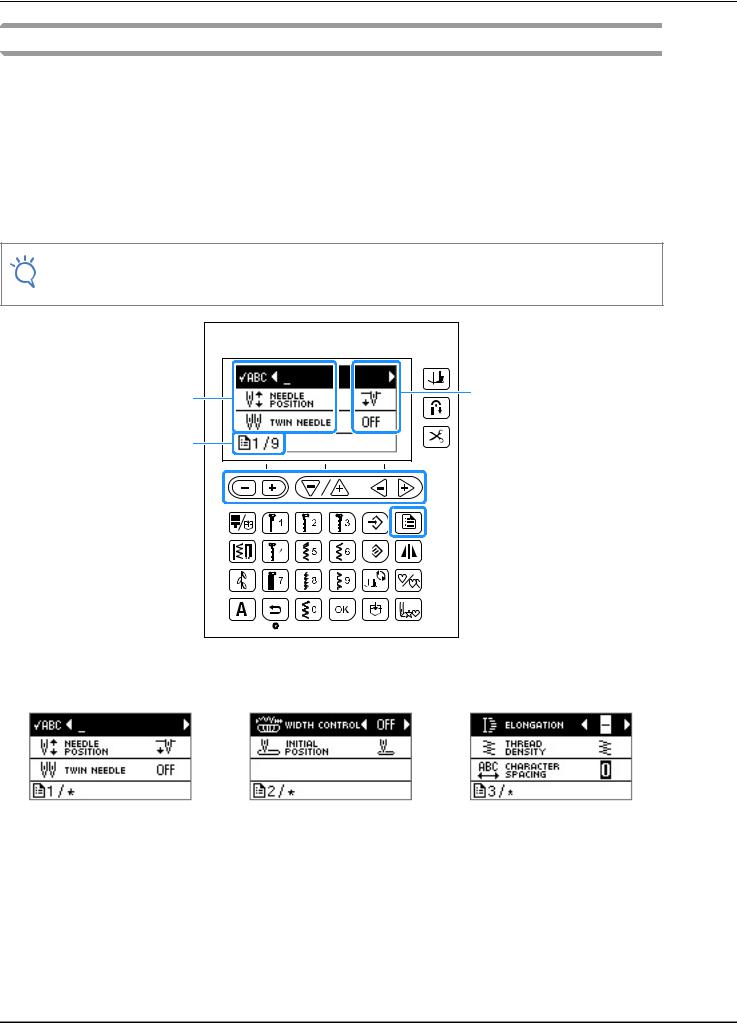
LCD
Settings screen
Press  to change various sewing machine operations and sewing settings. Press
to change various sewing machine operations and sewing settings. Press  to move to previous/next pages.
to move to previous/next pages.
* You can also move to next pages by pressing  .
.
Press 

 to select the next/previous items.
to select the next/previous items.
*Press  (Downward arrow) to select the next item.
(Downward arrow) to select the next item.
*Press  (Upward arrow) to select the previous item. Press
(Upward arrow) to select the previous item. Press 
 to change the value of the selected item.
to change the value of the selected item.
Note
•The parameters and number of pages in the settings screens differ depending on the model of your machine. For details on the settings screen for your machine, refer to the Quick Reference Guide.
2 |
3 |
|
|
1 |
|
1 Page number (The page numbers vary depending on your machine model.) 2 Machine settings
3 Value
1 |
|
4 |
|
|
6 |
|
|
|
|
|
|||
|
|
|
|
|||
|
|
|
|
|
||
2 |
|
5 |
|
7 |
|
|
|
|
|
||||
|
|
|
||||
3 |
|
|
8 |
|
||
|
|
|
||||
|
|
|
||||
1Use to check the pattern when the specified pattern is not displayed on the screen. For details, refer to “Checking the selected pattern” in the “Decorative sewing” section.
2 Select the needle stop position (the needle position for when the machine is not being operated) to be up or down. 3 Set to “ON” when using twin needle. For details, refer to “Using the twin needle” on page B-25.
4Allows the stitch width to be adjusted using the sewing speed controller. For details, refer to “Satin stitching using the sewing speed controller” in the “Sewing” section.
5Select either “01 Straight stitch (Left)” or “03 Straight stitch (Middle)” as the utility stitch that is automatically selected when the machine is turned on.
6Changes the stitch length when 7 mm satin stitch patterns are selected. For details, refer to “Changing the pattern length” in the “Decorative sewing” section.
7Changes the thread density when satin stitch patterns are selected. For details, refer to “Changing the stitch density” in the “Decorative sewing” section.
8 Changes the character spacing. For details, refer to “Changing character spacing” in the “Decorative sewing” section.
B-12
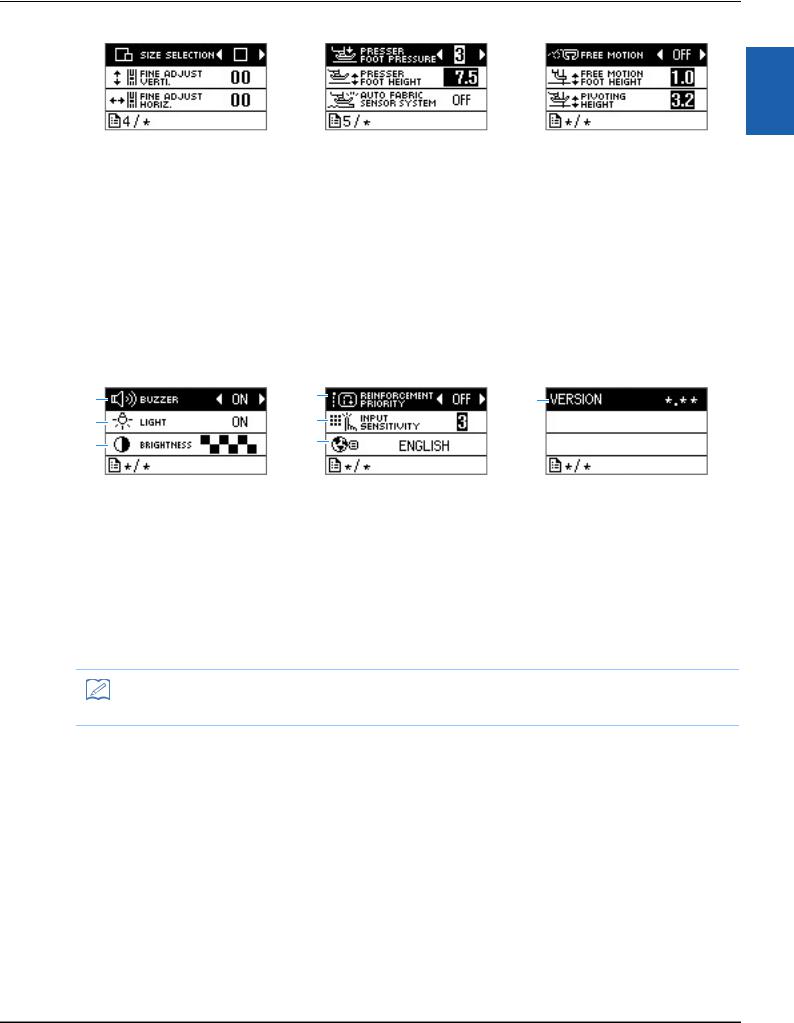
LCD
9 |
|
|
B |
|
|
|
E |
|
|
|
|
|
|
|
|||
0 |
|
|
C |
|
|
|
F |
|
|
|
|
|
|
|
|||
A |
|
|
D |
|
|
|
G |
|
|
|
|
|
|
|
B
9 Changes the size of the stitch pattern. For details, refer to “Changing the pattern size” in the “Decorative sewing” section.
0 Adjusts the up and down position of the pattern. For details, refer to “Realigning the pattern” in the “Decorative sewing” section.
AAdjusts the left and right position of the pattern. (Equipped on some models. Refer to page B-8.) For details on this function, refer to “Realigning the pattern” in the “Decorative sewing” section.
BAdjust the presser foot pressure. The higher the number, the greater the pressure will be. For details on this function, refer to “Adjusting the presser foot pressure” on page B-43.
C Adjust the height of the presser foot when the presser foot is raised. (Equipped on some models. Refer to page B-8.)
DWhen set to “ON” the thickness of the fabric is automatically detected by an internal sensor while sewing. This enables the fabric to be fed smoothly. (Equipped on some models. Refer to page B-8.) For details on this function, refer to “Automatic Fabric Sensor System (Automatic presser foot pressure)” on page B-43.
ESet to “ON” when sewing with the free motion mode. (Equipped on some models. Refer to page B-8.) For details on this function, refer to “Sewing with free motion mode” on page B-44.
FChange the height of the presser foot when the machine is set to free motion sewing mode. (Equipped on some models. Refer to page B-8.) For details on this function, refer to “Sewing with free motion mode” on page B-44.
GChange the height of the presser foot when sewing is stopped when the pivot key is selected. (Equipped on some models. Refer to page B-8.) For details on this function, refer to “Pivoting” on page B-43.
H K N
I L
J M
READY GETTING
H Specifies whether or not a beep is sounded with each operation. For details, refer to “Operation beep” in the “Appendix” section. I Switches the needle area and work area lights to remain “ON” or “OFF”.
J Adjusts the brightness of the LCD.
KWhen set “ON”, reinforcement stitches are sewn at the beginning and/or end of sewing for a reinforcement stitch pattern, even when the reverse button is pressed. For details, refer to “Automatic reinforcement stitching” on page B-37.
LSelect the level of the input sensitivity for operation keys. For details, refer to “Adjusting input sensitivity for operation keys” on page B-14.
M Selects the display language. For details, refer to “Choosing the display language” on page B-14.
N Displays the program version.
Memo
• Press  or
or  to return to the original screen.
to return to the original screen.
Basic operations B-13
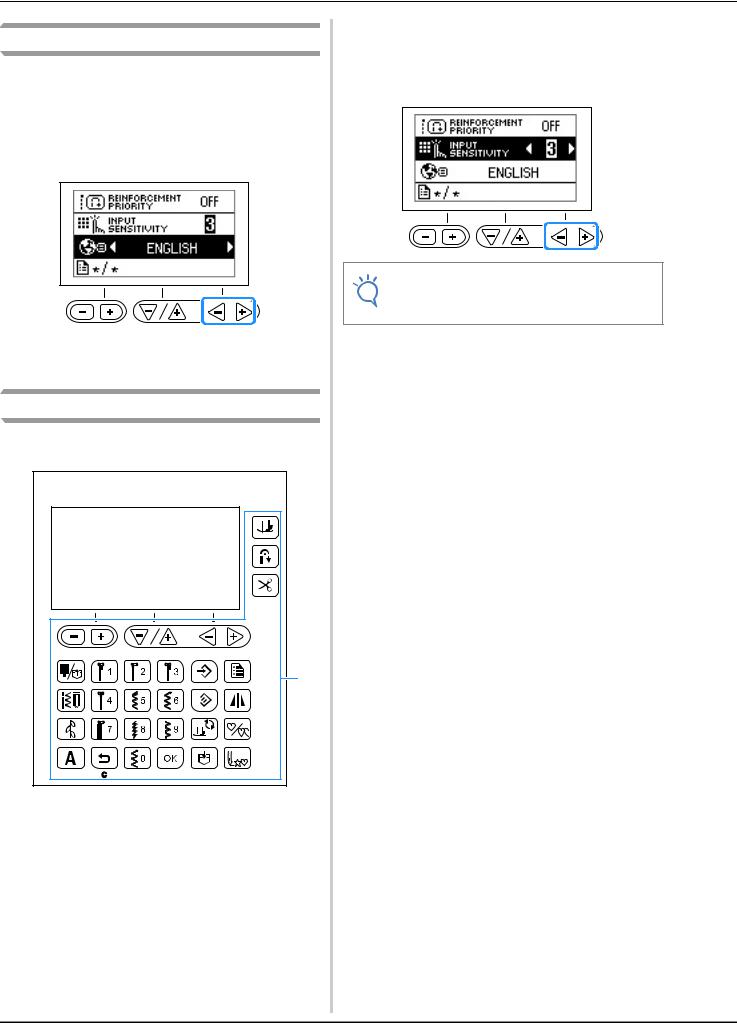
LCD
Choosing the display language
aPress  .
.
bSelect  (Language) display.
(Language) display.
cUse the “-” or “+” key to choose the desired language.
dPress  to return to the original screen.
to return to the original screen.
Adjusting input sensitivity for operation keys
You can adjust the sensitivity of the operation keys to five levels. Display the settings screen to set desired level.
1 |
1 Operation keys
aSelect  (Input sensitivity) in the settings screen.
(Input sensitivity) in the settings screen.
bAdjustkey. the input sensitivity by pressing the “-” or “+”
•The lower the setting, the less sensitive the keys will be; the higher the setting, the more sensitive the keys will be. The default setting is “3”.
Note
•We recommend selecting the highest setting if an electrostatic touch pen is being used.
■If the machine does not respond when an operation key is pressed
Hold down  (Thread cutter button) and turn on the machine to reset the settings. Display the settings screen, and then adjust the settings again.
(Thread cutter button) and turn on the machine to reset the settings. Display the settings screen, and then adjust the settings again.
B-14
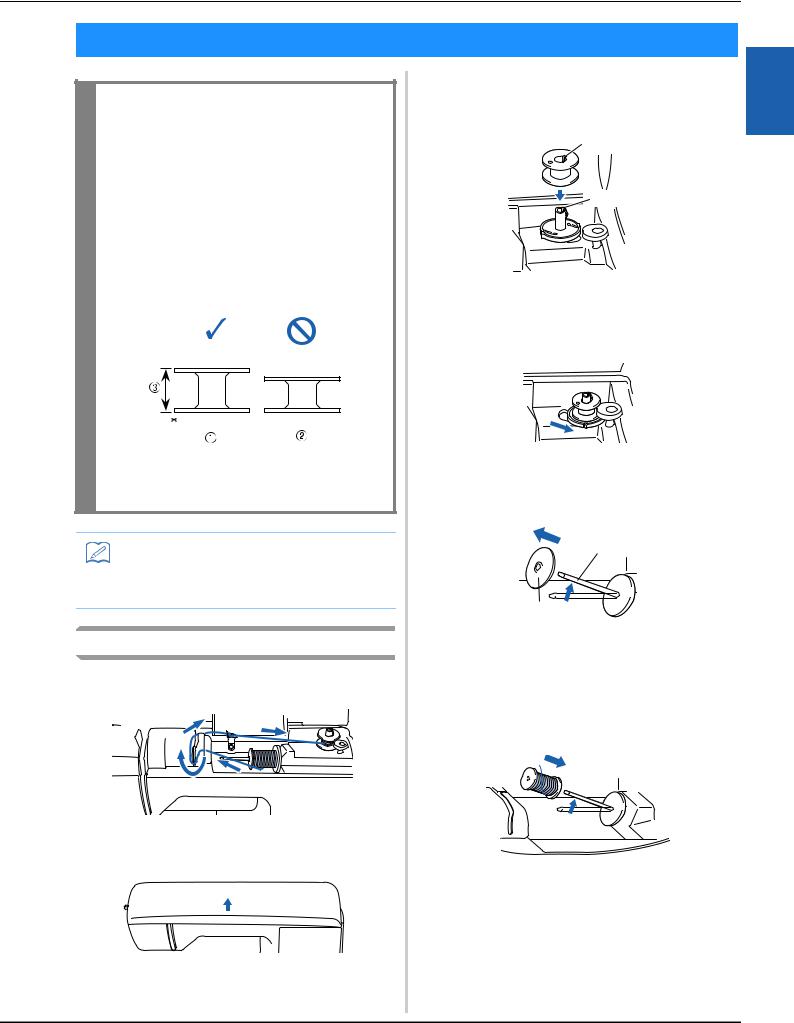
Winding/Installing the Bobbin
Winding/Installing the Bobbin
 CAUTION
CAUTION
•Only use the Bobbin (part code: SA156, SFB: XA5539-151) designed specifically for this machine. Use of any other bobbin may result in injuries or damage to the machine.
•The included bobbin was designed specifically for this machine.
If bobbins from other models are used, the machine will not operate correctly. Use only the included bobbin or bobbins of the same type (part code: SA156, SFB: XA5539-151). SA156 is Class15 type bobbin.
*Actual size
1 This model
2 Other models
3 11.5 mm (approx. 7/16 inch)
Memo
•When the foot controller is connected, bobbin winding can be started and stopped with the foot controller.
Winding the bobbin
This section describes how to wind thread onto a bobbin.
aOpen the top cover.
bPlace the bobbin on the bobbin winder shaft so that the spring on the shaft fits into the notch in the bobbin.
Press down on the bobbin until it snaps into place.
1
2
1 Notch
2 Bobbin winder shaft spring
cSlide the bobbin winder in the direction of the arrow until it snaps into place.
• The “Start/Stop” button lights up in orange.
dRemovepin. the spool cap that is inserted onto the spool
1
2
1 Spool pin
2 Spool cap
ePlacepin. the spool of thread for the bobbin onto the spool
Slide the spool onto the pin so that the spool is horizontal and the thread unwinds to the front at the bottom.
•If the spool is not positioned so that the thread unwinds correctly, the thread may become tangled around the spool pin.
B
READY GETTING
Basic operations B-15
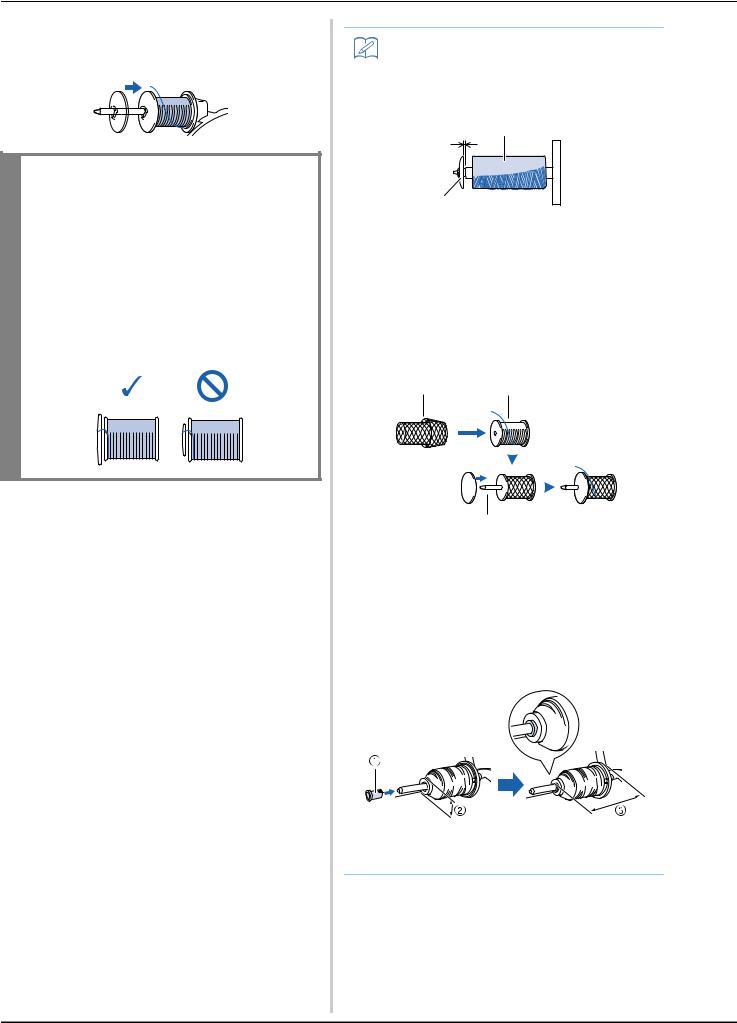
Winding/Installing the Bobbin
fSlide the spool cap onto the spool pin.
Slide the spool cap as far as possible to the right, as shown, with the rounded side on the left.
 CAUTION
CAUTION
•If the spool or the spool cap is not installed correctly, the thread may become tangled around the spool pin, causing the needle to break.
•Three spool cap sizes are available, allowing you to choose a spool cap that best fits the size of spool being used. If the spool cap is too small for the spool being used, the thread may catch on the slit in the spool or the machine may be damaged.
Memo
•When sewing with fine, cross-wound thread, use the small spool cap, and leave a small space between the cap and the spool.
c b
a 
1 Spool cap (small)
2 Spool (cross-wound thread)
3 Space
• When using thread that winds off quickly, such as transparent nylon thread or metallic thread, place the spool net over the spool before placing the spool of thread onto the spool pin.
If the spool net is too long, fold it to fit the size of the spool.
1 2
3

4
1 Spool net
2 Spool
3 Spool cap
4Spool pin
•If a spool of thread whose core is 12 mm (1/2 inch) in diameter and 75 mm (3 inches) high is inserted onto the spool pin, use the thread spool insert (mini king thread spool).
1 Thread spool insert (mini king thread spool)
2 12 mm (1/2 inch)
3 75 mm (3 inches)
B-16
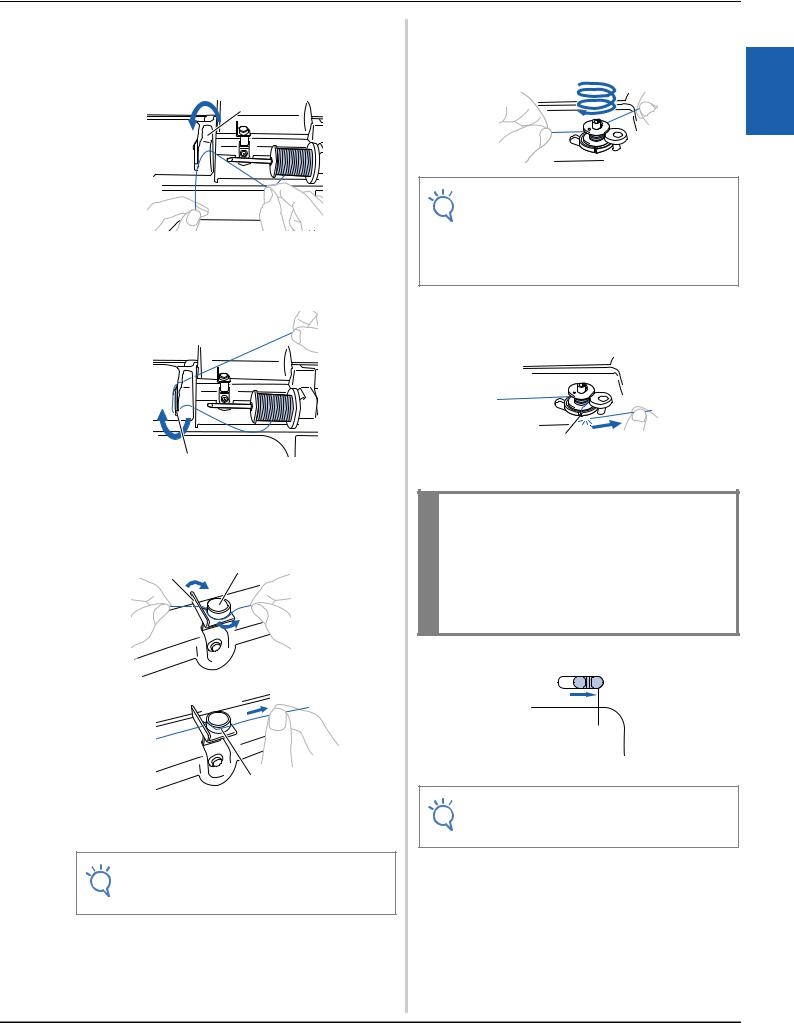
Winding/Installing the Bobbin
gWhile holding the thread near the spool with your right hand, as shown, pull the thread with your left hand, and then pass the thread behind the thread guide cover and to the front.
1
1 Thread guide cover
hPass the thread under the thread guide plate, and then pull it to the right.
1
1 Thread guide plate
iPass the thread under the hook on the thread guide, and then wind it counterclockwise under the pretension disk.
2
1
3
1 Thread guide
2 Pretension disk
3 Pull it in as far as possible
Note
•Make sure that the thread passes under the pretension disk.
jWhile holding the thread with your left hand, wind the thread that was pulled out clockwise around the bobbin five or six times with your right hand.
Note
•Make sure that the thread between the spool and the bobbin is pulled tight.
•Be sure to wind the thread clockwise around the bobbin, otherwise the thread will become wrapped around the bobbin winder shaft.
kPass the end of the thread through the guide slit in the bobbin winder seat, and then pull the thread to the right to cut it.
1
1Guide slit in bobbin winder seat (with built-in cutter)
 CAUTION
CAUTION
•Be sure to cut the thread as described. If the bobbin is wound without cutting the thread using the cutter built into the slit in the bobbin winder seat, the thread may become tangled in the bobbin or the needle may bend or break when the bobbin thread starts to run out.
lSlide the sewing speed controller to the right.
1
1 Speed controller
Note
•Bobbin winding speeds may vary depending on type of thread being wound on bobbin.
mTurn on the machine.
B
READY GETTING
Basic operations B-17
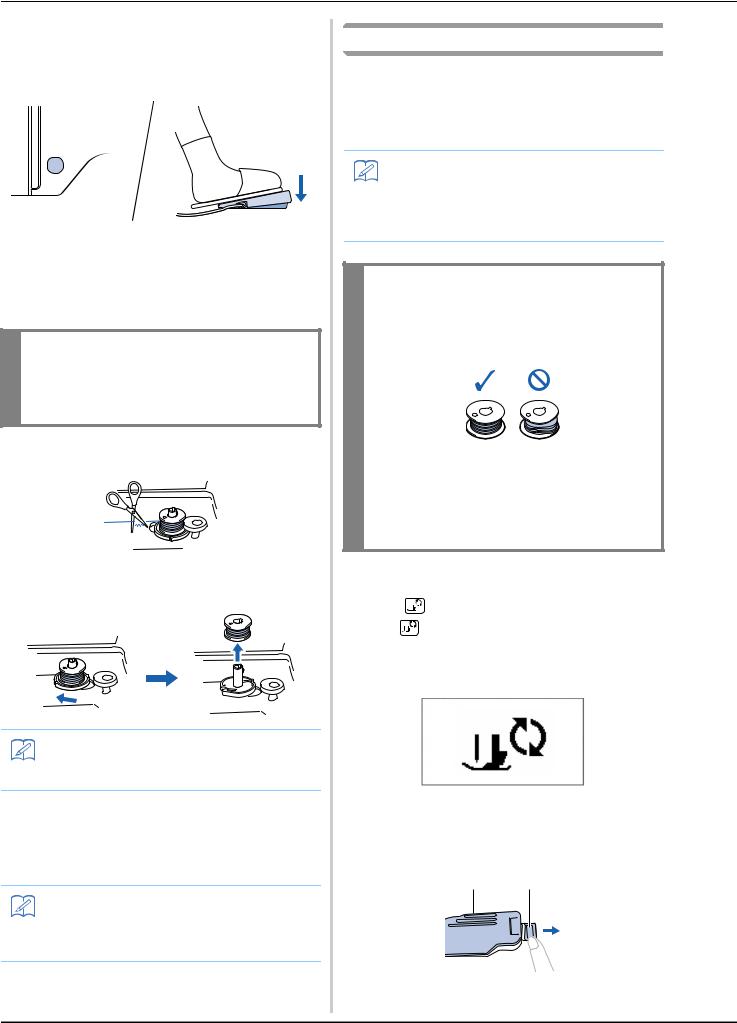
Winding/Installing the Bobbin
nPressbobbin.the “Start/Stop” button once to start winding the When the foot controller is plugged in, press down on the foot controller.
 1
1
1 “Start/Stop” button
oWhen the bobbin winding becomes slow, press the “Start/Stop” button once to stop the machine. When the foot controller is plugged in, remove your foot from the foot controller.
 CAUTION
CAUTION
•When the bobbin winding becomes slow, stop the machine, otherwise the machine may be damaged.
pUsethe bobbin.scissors to cut the end of the thread wound around
qSlide the bobbin winder shaft to the left, and then remove the bobbin from the shaft.
Memo
•If the bobbin winder shaft is set to the right side, the needle will not move. (Sewing is impossible.)
rSlide the sewing speed controller back to desired sewing speed position.
sRemovepin. the spool for the bobbin thread from the spool
Memo
•When the machine is started or the handwheel is turned after winding the bobbin, the machine will make a clicking sound; this is not a malfunction.
Installing the bobbin
Install the bobbin wound with thread.
You can begin sewing immediately without pulling up the bobbin thread by simply inserting the bobbin in the bobbin case and guiding the thread through the slit in the needle plate cover.
Memo
•For details on sewing after pulling up the bobbin thread, for example, when making gathers or with free motion quilting, refer to “Pulling up the bobbin thread” on page B-24.
 CAUTION
CAUTION
•Use a bobbin that has been correctly wound with thread, otherwise the needle may break or the thread tension will be incorrect.
•Before inserting or changing the bobbin, be
sure to press  (Presser foot/Needle exchange key) on the operation panel to lock all keys and buttons, otherwise injuries may occur if the “Start/Stop” button or any other button is pressed and the machine starts.
(Presser foot/Needle exchange key) on the operation panel to lock all keys and buttons, otherwise injuries may occur if the “Start/Stop” button or any other button is pressed and the machine starts.
aPress  (Needle position button) once or twice to raise the needle, and then lower the presser foot lever.
(Needle position button) once or twice to raise the needle, and then lower the presser foot lever.
bPress |
. |
• If |
is pressed while the presser foot is raised, an |
error message appears. Lower the presser foot.
→The screen changes, and all keys and operation buttons are locked (except  ).
).
cRaise the presser foot lever.
dSlide the bobbin cover latch to the right.
1 2
1 Bobbin cover
2 Latch
B-18
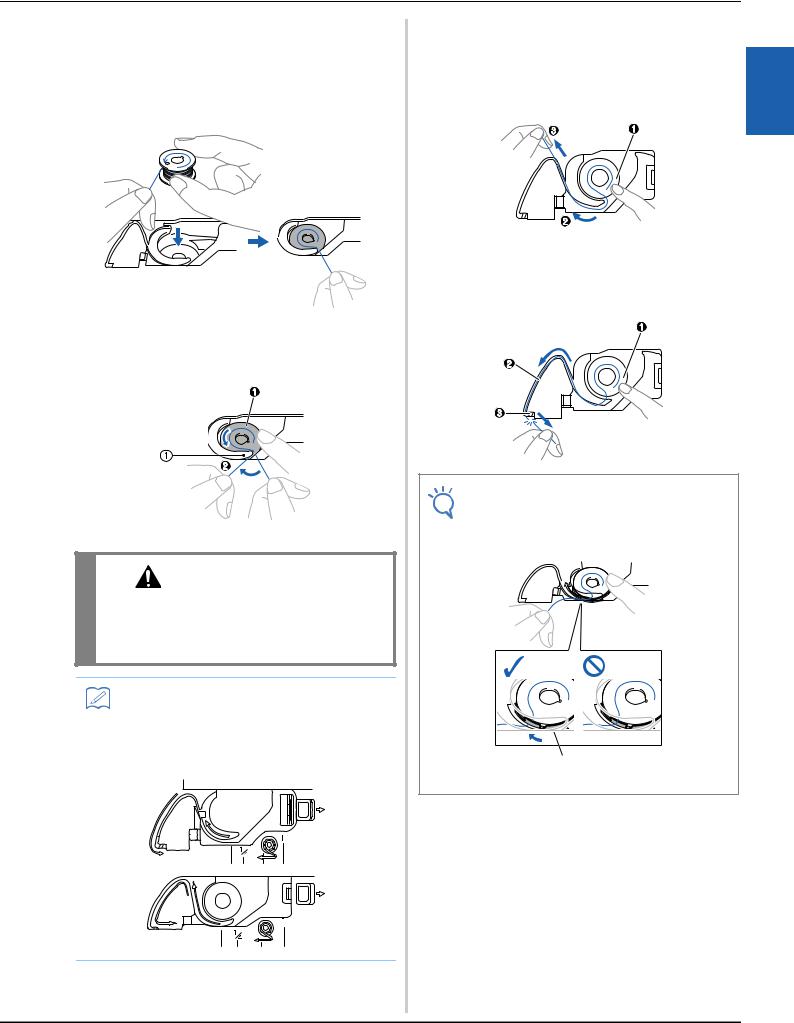
Winding/Installing the Bobbin
eRemove the bobbin cover.
fHold the bobbin with your right hand with the thread unwinding to the left, and hold the end of the thread with your left hand. Then, with your right hand, place the bobbin in the bobbin case.
gLightly hold down the bobbin with your right hand (1), and then guide the end of the thread around the tab of the needle plate cover with your left hand (2).
1 Tab
CAUTION
•Be sure to hold down the bobbin with your finger and unwind the bobbin thread correctly, otherwise the thread may break or the thread tension will be incorrect.
Memo
•The order that the bobbin thread should be passed through the bobbin case is indicated by marks around the bobbin case. Be sure to thread the machine as indicated.
hWhile lightly holding down the bobbin with your right hand (1), guide the thread through the slit in the needle plate cover (2) and lightly pull it with your left hand (3).
•The thread enters the tension spring of the bobbin case.
iWhile lightly holding down the bobbin with your right hand (1), continue guiding the thread through the slit with your left hand (2) Then, cut the thread with the cutter (3).
Note
•If the thread is not correctly inserted through the tension-adjusting spring of the bobbin case, it may cause incorrect thread tension.
1
1 Tension-adjusting spring
B
READY GETTING
Basic operations B-19

Winding/Installing the Bobbin
jReattach the bobbin cover.
Insert the tab in the lower-left corner of the bobbin cover, and then lightly press down on the right side.
 2
2
 1
1
→ The bobbin threading is finished.
Next, thread the upper thread. Continue with the procedure in “Upper Threading” on page B-21.
Memo
•You can begin sewing without pulling up the bobbin thread. If you wish to pull up the bobbin thread before starting to sew, pull up the thread according to the procedure in “Pulling up the bobbin thread” on page B-24.
kPress  to unlock all keys and buttons.
to unlock all keys and buttons.
B-20

Upper Threading
Upper Threading
 CAUTION
CAUTION
•Three spool cap sizes are available, allowing you to choose a spool cap that best fits the size of spool being used. If the spool cap is too small for the spool being used, the thread may catch on the slit in the spool or the needle may break. For more information regarding the choice of spool caps for your thread choice, see page B-16.
•When threading the upper thread, carefully follow the instructions. If the upper threading is not correct, the thread may become tangled or the needle may bend or break.
•Never use a thread weight of 20 or lower.
•Use the needle and the thread in the correct combination. For details on the correct combination of needles and threads, refer to “Fabric/thread/needle combinations” on page B-28.
Threading the upper thread
aTurn on the machine.
bRaise the presser foot lever to raise the presser foot.
1
1 Presser foot lever
→The upper thread shutter opens so the machine can be threaded.
Note
•If the presser foot is not raised, the machine cannot be threaded.
cPress  (Needle position button) once or twice to raise the needle.
(Needle position button) once or twice to raise the needle.
1
1 Needle position button
→The needle is correctly raised when the mark on the handwheel is at the top, as shown below. Check the
handwheel and, if this mark is not at this position, press  (Needle position button) until it is.
(Needle position button) until it is.
1
1 Mark on handwheel
dRemovepin. the spool cap that is inserted onto the spool
1
2
1 Spool pin
2 Spool cap
B
READY GETTING
Basic operations B-21
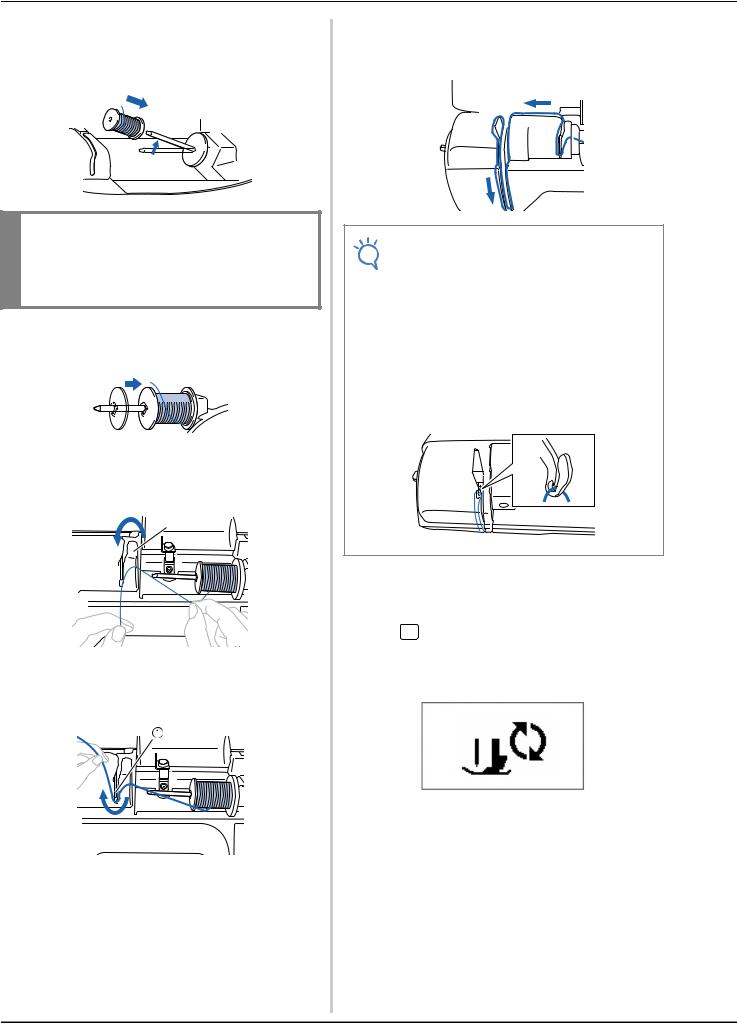
Upper Threading
ePlace the spool of thread onto the spool pin.
Slide the spool onto the pin so that the spool is horizontal and the thread unwinds to the front at the bottom.
 CAUTION
CAUTION
•If the spool or the spool cap is not positioned correctly, the thread may become tangled around the spool pin or the needle may break.
fSlide the spool cap onto the spool pin.
Slide the spool cap as far as possible to the right, as shown, with the rounded side on the left.
gWhile holding the thread lightly with your right hand, pull the thread with your left hand, and then pass the thread behind the thread guide cover and to the front.
1
1 Thread guide cover
hPasspull ittheup.thread under the thread guide plate, and then
1 Thread guide plate
iWhile using your right hand to lightly hold the thread passed under the thread guide plate, pass the thread through the guides in the order shown below.
Note
•If the presser foot has been lowered and the shutter is closed, the machine cannot be threaded. Be sure to raise the presser foot to open the shutter before threading the machine. In addition, before removing the upper thread, be sure to raise the presser foot to open the shutter.
•This machine is equipped with a window that allows you to check the position of the take-up lever. Look through this window and check that the thread is correctly fed through the take-up lever.
jLower the presser foot.
kPress  .
.
•If 
 is pressed while the presser foot is raised, an error message appears. Lower the presser foot.
is pressed while the presser foot is raised, an error message appears. Lower the presser foot.
→The screen changes, and all keys and operation buttons are locked (except  ).
).
B-22
